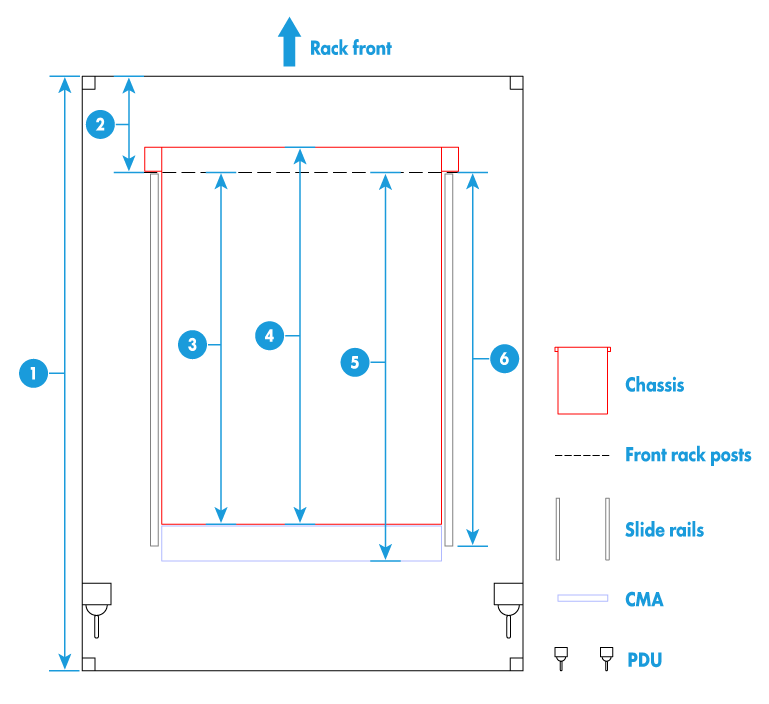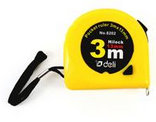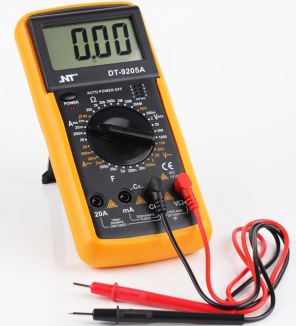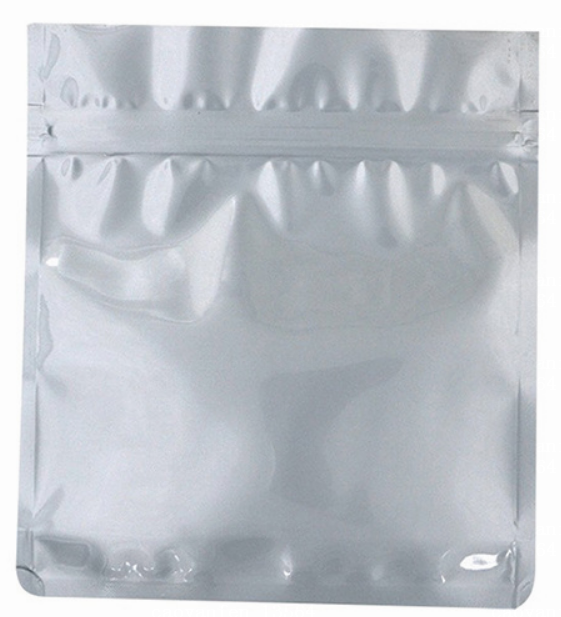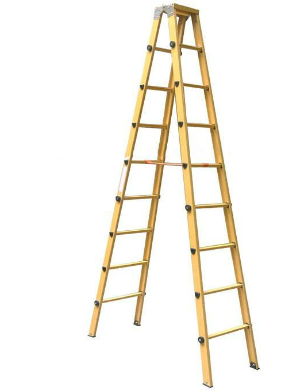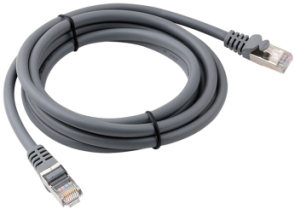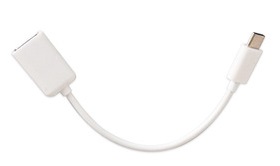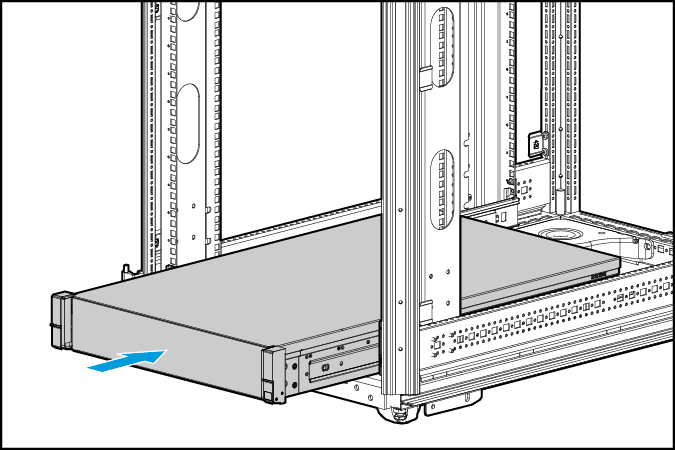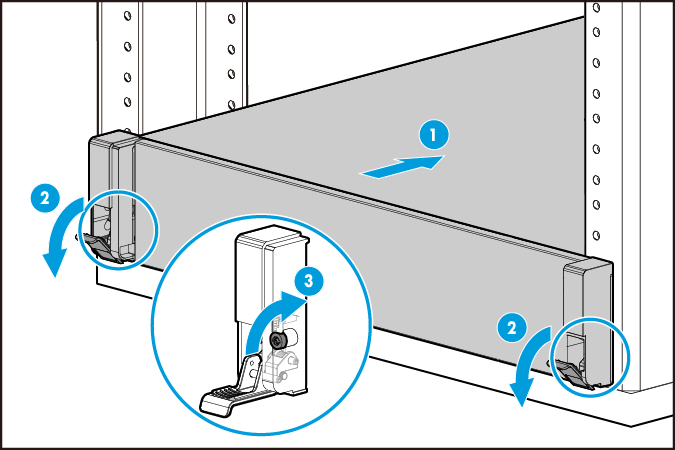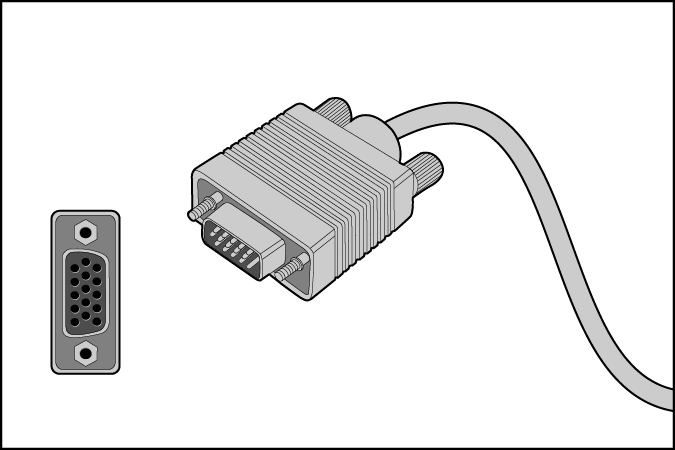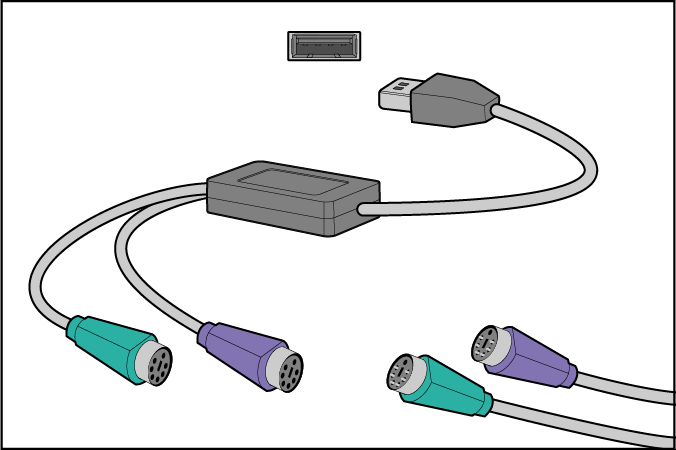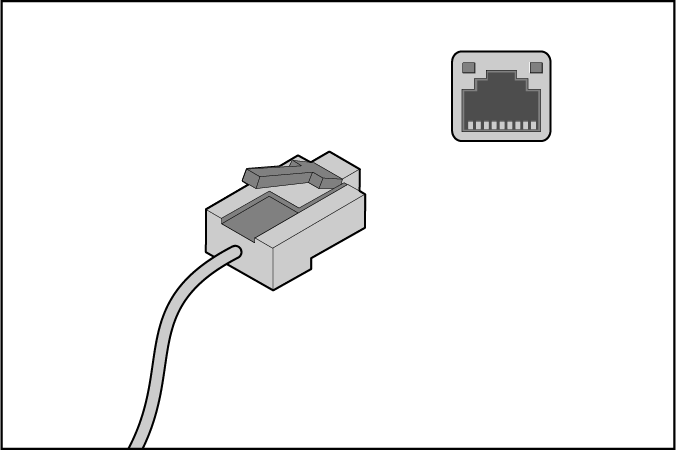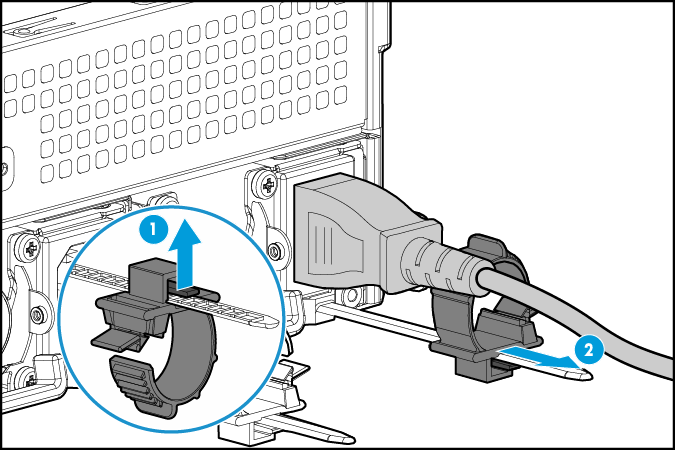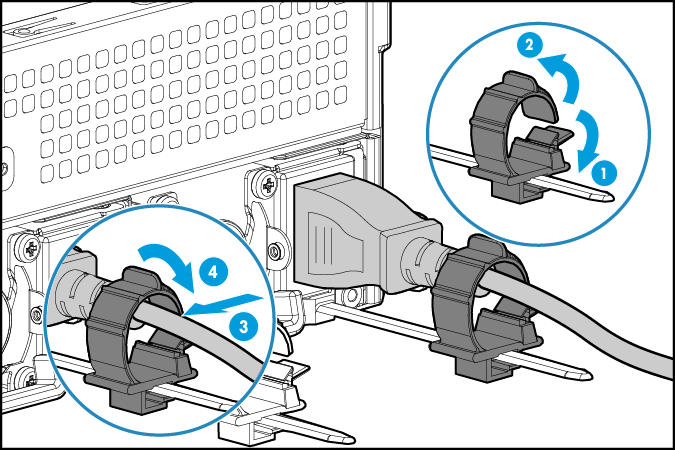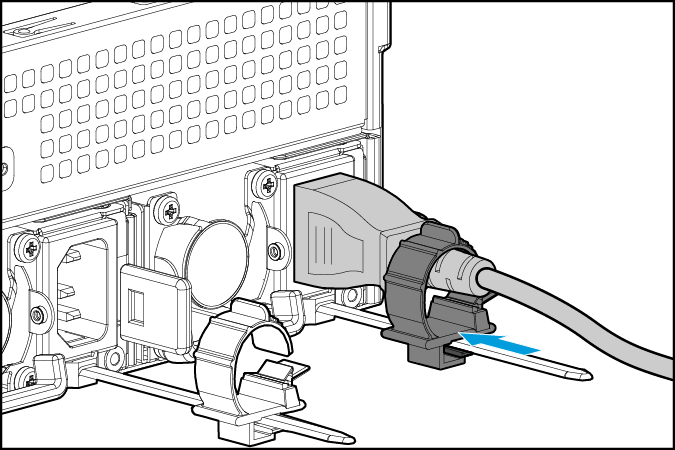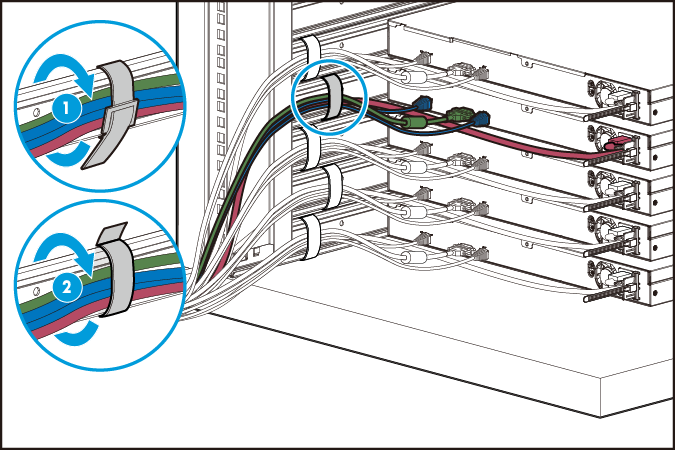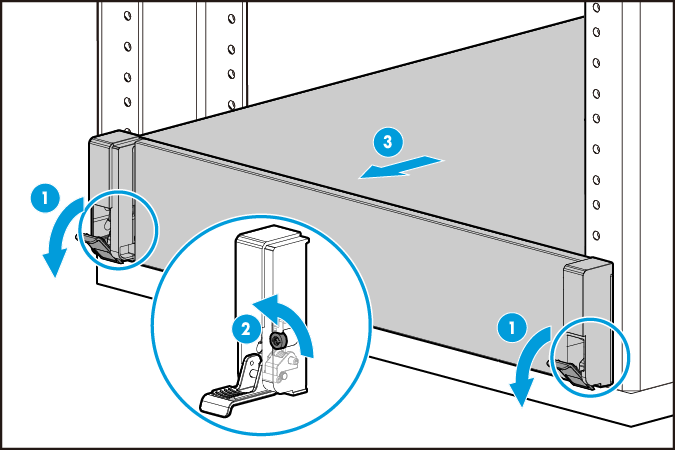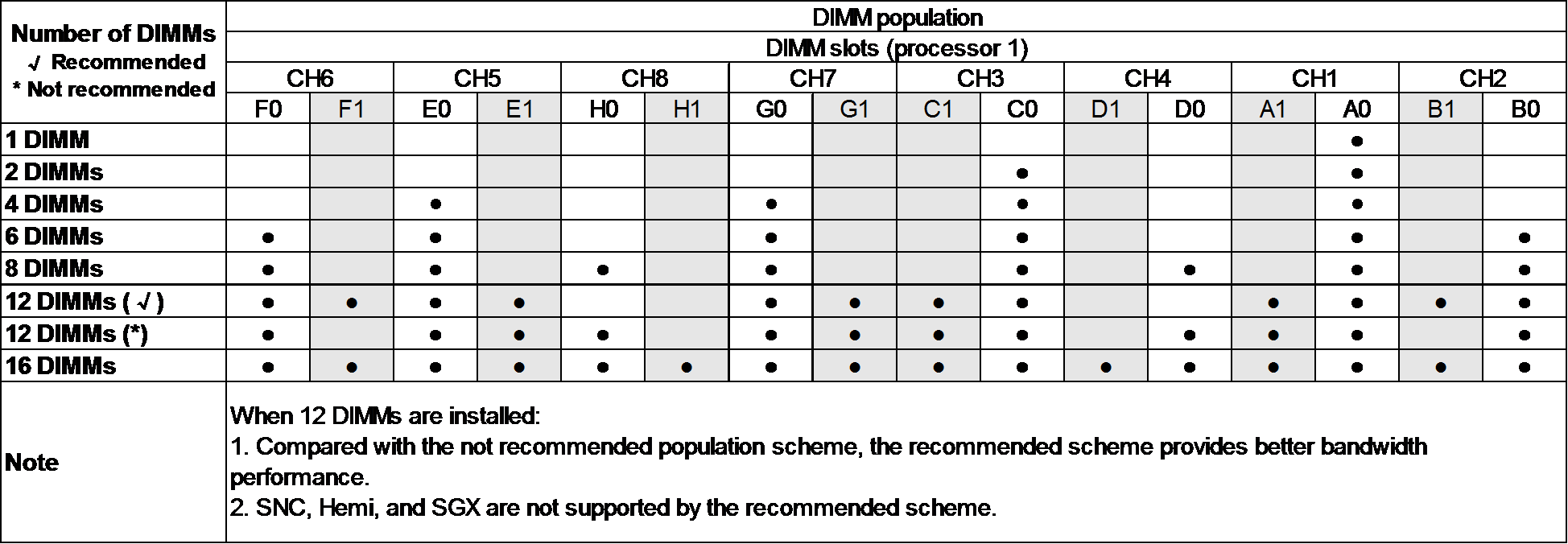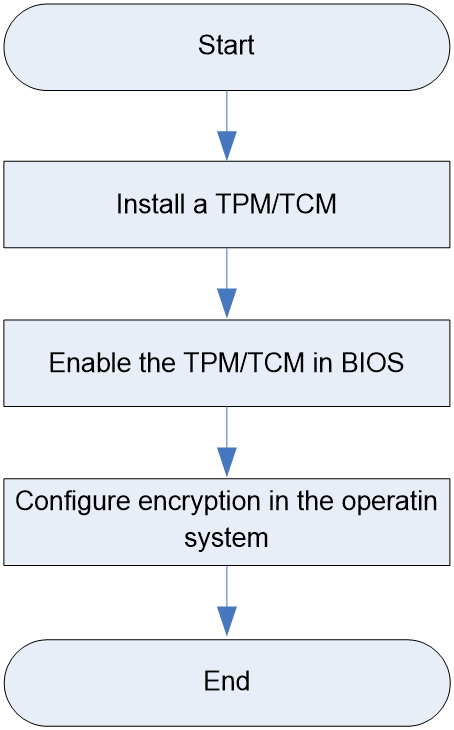- Table of Contents
- Related Documents
-
| Title | Size | Download |
|---|---|---|
| 01-Text | 21.23 MB |
Installation safety recommendations
Installation site requirements
Airflow direction of the server
Temperature and humidity requirements
Equipment room height requirements
Corrosive gas concentration requirements
Installing or removing the server
Installing cable management brackets
Connecting a mouse, keyboard, and monitor
Removing the server from a rack
Powering on and powering off the server
Configuring basic BIOS settings
Installing the operating system and hardware drivers
Installing the operating system
Removing the chassis air baffle
Installing the chassis air baffle
Installing the T-shape bracket
Removing the blank above the power supplies
Installing the blank above the power supplies
Removing the riser card blank over PCIe riser connector 1 or 2
Installing the riser card blank over PCIe riser connector 1 or 2
Removing the riser card blank over PCIe riser connector 3 or 4
Installing the riser card blank over PCIe riser connector 3 or 4
Installing a power supply blank
Installing a PCIe module blank
Removing the blank from the OCP network adapter slot
Installing the blank to the OCP network adapter slot
Replacing the intelligent security bezel
Removing the intelligent security bezel
Installing the intelligent security bezel
Replacing a front drive backplane
Removing a front drive backplane
Installing a front drive backplane
Replacing a rear drive backplane
Removing a rear drive backplane
Installing a rear drive backplane
Replacing riser cards and PCIe modules
Removing a riser card and a PCIe module
Installing a riser card and a PCIe module
Replacing a storage controller and a power fail safeguard module
Removing a standard storage controller and a power fail safeguard module
Installing a standard storage controller and a power fail safeguard module
Replacing a standard PCIe network adapter
Removing a standard PCIe network adapter
Installing a standard PCIe network adapter
Replacing an OCP network adapter
Removing an OCP network adapter
Installing an OCP network adapter
Replacing a SATA M.2 SSD and a SATA M.2 SSD expander module
Removing a SATA M.2 SSD and a SATA M.2 SSD expander module
Installing a SATA M.2 SSD and a SATA M.2 SSD expander module
Replacing a dual SD card extended module
Removing a dual SD card extended module
Installing a dual SD card extended module
Installing and setting up a TCM or TPM
Installation and setup flowchart
Enabling the TCM or TPM in the BIOS
Configuring encryption in the operating system
Replacing the NVMe VROC module
Installing the NVMe VROC module
Connecting power cords for fan adapters
Connecting supercapacitor extension cables
Connecting the SATA M.2 SSD data cables
Connecting the PCIe signal cables
Connecting cables to chassis ears
Monitoring the temperature and humidity in the equipment room
Updating firmware for the server
Safety information
Safety sign conventions
To avoid bodily injury or damage to the server or its components, make sure you are familiar with the safety signs on the server chassis or its components.
|
Sign |
Description |
|
Circuit or electricity hazards are present. Only H3C authorized or professional server engineers are allowed to service, repair, or upgrade the server. To avoid bodily injury or damage to circuits, do not open any components marked with the electrical hazard sign unless you have authorization to do so. |
|
|
Electrical hazards are present. Field servicing or repair is not allowed. To avoid bodily injury, do not open any components with the field-servicing forbidden sign in any circumstances. |
|
|
The RJ-45 ports on the server can be used only for Ethernet connections. To avoid electrical shocks, fire, or damage to the equipment, do not connect an RJ-45 port to a telephone. |
|
|
The surface or component might be hot and present burn hazards. To avoid being burnt, allow hot surfaces or components to cool before touching them. |
|
|
The server or component is heavy and requires more than one people to carry or move. To avoid bodily injury or damage to hardware, do not move a heavy component alone. In addition, observe local occupational health and safety requirements and guidelines for manual material handling. |
|
|
The server is powered by multiple power supplies. To avoid bodily injury from electrical shocks, make sure you disconnect all power supplies if you are performing offline servicing. |
Power source recommendations
Power instability or outage might cause data loss, service disruption, or damage to the server in the worst case.
To protect the server from unstable power or power outage, use uninterrupted power supplies (UPSs) to provide power for the server.
Installation safety recommendations
To avoid bodily injury or damage to the server, read the following information carefully before you operate the server.
General operating safety
To avoid bodily injury or damage to the server, follow these guidelines when you operate the server:
· Only H3C authorized or professional server engineers are allowed to install, service, repair, operate, or upgrade the server.
· Place the server on a clean, stable table or floor for servicing.
· Make sure all cables are correctly connected before you power on the server.
· To avoid being burnt, allow the server and its internal modules to cool before touching them.
Electrical safety
|
WARNING! If you put the server in standby mode (system power LED in amber) with the power on/standby button on the front panel, the power supplies continue to supply power to some circuits in the server. To remove all power for servicing safety, you must first press the button, wait for the system to enter standby mode, and then remove the power cords from the server. |
To avoid bodily injury or damage to the server, follow these guidelines:
· Always use the power cords that came with the server.
· Do not use the power cords that came with the server for any other devices.
· Power off the server when installing or removing any components that are not hot swappable.
Rack mounting recommendations
To avoid bodily injury or damage to the equipment, follow these guidelines when you rack mount a server:
· Mount the server in a standard 19-inch rack.
· Make sure the leveling jacks are extended to the floor and the full weight of the rack rests on the leveling jacks.
· Couple the racks together in multi-rack installations.
· Load the rack from the bottom to the top, with the heaviest hardware unit at the bottom of the rack.
· Get help to lift and stabilize the server during installation or removal, especially when the server is not fastened to the rails. As a best practice, a minimum of two people are required to safely load or unload a rack. A third person might be required to help align the server if the server is installed higher than check level.
· For rack stability, make sure only one unit is extended at a time. A rack might get unstable if more than one server unit is extended.
· Make sure the rack is stable when you operate a server in the rack.
· To maintain correct airflow and avoid thermal damage to the server, use blank panels to fill empty rack units.
ESD prevention
Preventing electrostatic discharge
To prevent electrostatic damage, follow these guidelines:
· Transport or store the server with the components in antistatic bags.
· Keep the electrostatic-sensitive components in separate antistatic bags until they arrive at an ESD-protected area.
· Place the components on a grounded surface before removing them from their antistatic bags.
· Avoid touching pins, leads, or circuitry.
Grounding methods to prevent electrostatic discharge
The following are grounding methods that you can use to prevent electrostatic discharge:
· Wear an ESD wrist strap and make sure it makes good skin contact and is reliably grounded.
· Take adequate personal grounding measures, including wearing antistatic clothing and static dissipative shoes.
· Use conductive field service tools.
· Use a portable field service kit with a folding static-dissipating work mat.
Cooling performance
Poor cooling performance might result from improper airflow and poor ventilation and might cause damage to the server.
To ensure good ventilation and proper airflow, follow these guidelines:
· Install blanks if the following module slots are empty:
¡ Drive bays.
¡ Fan bays.
¡ PCIe slots.
¡ Power supply slots.
· Do not block the ventilation openings in the server chassis.
· To avoid thermal damage to the server, do not operate the server for long periods in any of the following conditions:
¡ Access panel open or uninstalled.
¡ Air baffles uninstalled.
¡ PCIe slots, drive bays, fan bays, or power supply slots empty.
Battery safety
The server's system board contains a system battery, which is designed with a lifespan of 3 to 5 years.
If the server no longer automatically displays the correct date and time, you might need to replace the battery. When you replace the battery, follow these safety guidelines:
· Do not attempt to recharge the battery.
· Do not expose the battery to a temperature higher than 60°C (140°F).
· Do not disassemble, crush, puncture, short external contacts, or dispose of the battery in fire or water.
· Dispose of the battery at a designated facility. Do not throw the battery away together with other wastes.
Preparing for installation
Prepare a rack that meets the rack requirements and plan an installation site that meets the requirements for space and airflow, temperature, humidity, equipment room height, cleanliness, and grounding.
Rack requirements
|
IMPORTANT: To avoid affecting the server chassis, install power distribution units (PDUs) with the outputs facing backwards. If you install PDUs with the outputs facing the inside of the server, perform onsite survey to make sure the cables won't affect the server rear. |
The server is 4U high and has a depth of 781 mm (30.75 in). The rack for installing the server must meet the following requirements:
· A standard 19-inch rack.
· A clearance of more than 50 mm (1.97 in) between the rack front posts and the front rack door.
· A minimum of 1200 mm (47.24 in) in depth as a best practice. For installation limits for different rack depth, see Table 2.
Table 2 Installation limits for different rack depths
|
Rack depth |
Installation limits |
|
1000 mm (39.37 in) |
· The H3C cable management arm (CMA) is not supported. · A clearance of 60 mm (2.36 in) is reserved from the server rear to the rear rack door for cabling. · The slide rails and PDUs might hinder each other. Perform onsite survey to determine the PDU installation location and the proper PDUs. If the PDUs hinder the installation and movement of the slide rails anyway, use other methods to support the server, a tray for example. |
|
1100 mm (43.31 in) |
Make sure the CMA does not hinder PDU installation at the server rear before installing the CMA. If the CMA hinders PDU installation, use a deeper rack or change the installation locations of PDUs. |
|
1200 mm (47.24 in) |
Make sure the CMA does not hinder PDU installation or cabling. If the CMA hinders PDU installation or cabling, change the installation locations of PDUs. For detailed installation suggestions, see Figure 1. |
Figure 1 Installation suggestions for a 1200 mm deep rack (top view)
|
(1) 1200 mm (47.24 in) rack depth |
|
(2) A minimum of 50 mm (1.97 in) between the front rack posts and the front rack door |
|
(3) 780 mm (30.71 in) between the front rack posts and the rear of the chassis, including power supply handles at the server rear (not shown in the figure) |
|
(4) 800 mm (31.50 in) server depth, including chassis ears |
|
(5) 960 mm (37.80 in) between the front rack posts and the CMA |
|
(6) 860 mm (33.86 in) between the front rack posts and the rear ends of the slide rails |
Installation site requirements
Airflow direction of the server
Figure 2 Airflow direction of the server

|
(1) to (2) Directions of the airflow into the chassis and power supplies |
|
(3) to (5) Directions of the airflow out of the chassis and power supplies |
Temperature and humidity requirements
To ensure correct operation of the server, make sure the room temperature and humidity meet the requirements as described in Appendix A Server specifications.
Equipment room height requirements
To ensure correct operation of the server, make sure the equipment room height meets the requirements as described in Appendix A Server specifications.
Corrosive gas concentration requirements
Corrosive gases can accelerate corrosion and aging of metal components and even cause server failure. Table 3 describes common corrosive gases and their sources.
Table 3 Common corrosive gases and their sources
|
Corrosive gas |
Sources |
|
Hydrogen sulfide (H2S) |
Geothermal emissions, microbiological activities, fossil fuel processing, wood pulping, sewage treatment, combustion of fossil fuel, auto emissions, ore smelting, and sulfuric acid manufacture. |
|
Sulfur dioxide (SO2) and sulfur trioxide (SO3) |
Combustion of fossil fuel, auto emissions, ore smelting, sulfuric acid manufacture, and tobacco smoke. |
|
Sulphur (S) |
Foundries and sulfur manufacture. |
|
Hydrogen Fluoride (HF) |
Fertilizer manufacture, aluminum manufacture, ceramics manufacture, steel manufacture, electronics device manufacture, and fossil fuel. |
|
Nitrogen Oxide (NOx) |
Automobile emissions, fossil fuel combustion, microbes, and chemical industry. |
|
Ammonia (NH3) |
Microbes, sewage, fertilizer manufacture, geothermal steam, refrigeration equipment, cleaning products, and reproduction (blueprint) machines. |
|
Carbonic oxide (CO) |
Combustion, automobile emissions, microbes, trees, and wood pulping. |
|
Chlorine (Cl2) and chlorine dioxide (ClO2) |
Chlorine manufacture, aluminum manufacture, papermills, refuse decomposition, and cleaning products. |
|
Hydrochloric acid (HCl) |
Automobile emissions, combustion, oceanic processes, and polymer combustion. |
|
Hydrobromic acid (HBr) and hydroiodic acid (HI) |
Automobile emissions. |
|
Ozone (O3) |
Atmospheric photochemical processes mainly involving nitrogen oxides and oxygenated hydrocarbons, automotive emissions, and electrostatic filters. |
|
Hydrocarbons (CnHn) |
Automobile emissions, fossil fuel processing, tobacco smoke, water treatment, microbes, paper mill, and many other sources, both natural and industrial. |
Requirements of corrosive gas concentration vary by server model. For information about the requirements, see the installation guide of the server.
Requirements for the data center equipment room
As a best practice, make sure the corrosive gas concentration for the data center equipment room meets the requirements of severity level G1 of ANSI/ISA 71.04-1985. The rate of copper corrosion product thickness growth must be less than 300 Å/month, and the rate of silver corrosion product thickness growth must be less than 200 Å/month. Angstrom (Å) is a metric unit of length equal to one ten-billionth of a meter.
To meet the copper and silver corrosion rates stated in severity level G1, make sure the corrosive gases in the equipment room do not exceed the concentration limits as shown in Table 4.
Table 4 Corrosive gas concentration limits in the data center equipment room
|
Corrosive gas |
Concentration (ppb) |
Remarks |
|
H2S |
< 3 |
The concentration limits are calculated based on the reaction results of the gases in the equipment room with a relative humidity less than 50%. If the relative humidity of the equipment room increases by 10%, the severity level of ANSI/ISA 71.04-1985 to be meet must also increase by 1. |
|
SO2, SO3 |
< 10 |
|
|
Cl2 |
< 1 |
|
|
NOx |
< 50 |
|
|
HF |
< 1 |
|
|
NH3 |
< 500 |
|
|
O3 |
< 2 |
|
|
NOTE: Part per billion (ppb) is a concentration unit. 1 ppb represents a volume-to-volume ratio of 1 to 100000000. |
Requirements for the non-data center equipment room
The corrosive gas concentration for the non-data center equipment room must meet the requirements of class 3C2 of IEC 60721-3-3:2002, as shown in Table 5.
Table 5 Corrosive gas concentration limits in the non-data center equipment room
|
Gas |
Average concentration (mg/m3) |
Maximum concentration (mg/m3) |
|
SO2 |
0.3 |
1.0 |
|
H2S |
0.1 |
0.5 |
|
Cl2 |
0.1 |
0.3 |
|
HCI |
0.1 |
0.5 |
|
HF |
0.01 |
0.03 |
|
NH3 |
1.0 |
3.0 |
|
O3 |
0.05 |
0.1 |
|
NOX |
0.5 |
1.0 |
|
CAUTION: As a best practice, control the corrosive gas concentrations in the equipment room at their average values. Make sure the corrosive gas concentrations do not exceed 30 minutes per day at their maximum values. |
Guidelines for controlling corrosive gases
To control corrosive gases, follow these guidelines:
· As a best practice, do not build the equipment room in a place with a high concentration of corrosive gases.
· Make sure the equipment room is not connected to sewer, sewage, vertical shaft, or septic tank pipelines and keep it far away from these pipelines. The air inlet of the equipment room must be away from such pollution sources.
· Use environmentally friendly materials to decorate the equipment room. Avoid using organic materials that contains harmful gases, such as sulfur or chlorine-containing insulation cottons, rubber mats, sound-proof cottons, and avoid using plasterboards with high sulfur concentration.
· Place fuel (diesel or gasoline) engines separately. Do not place them in the same equipment room with the device. Make sure the exhausted air of the engines will not flow into the equipment room or towards the air inlet of the air conditioners.
· Place batteries separately. Do not place them in the same room with the device.
· Employ a professional company to monitor and control corrosive gases in the equipment room regularly.
Cleanliness requirements
Requirements of dust particle concentration vary by server model. For information about the requirements, see the installation guide of the server.
Requirements for the data center equipment room
The concentration of dust participles in the equipment room must meet the ISO 8 cleanroom standard defined by ISO 14644-1, as described in Table 6. Make sure no zinc whiskers are in the equipment room.
Table 6 Dust particle concentration limit in the equipment room
|
Particle diameter |
Concentration limit |
|
≥ 5 µm |
≤ 29300 particles/m3 |
|
≥ 1 µm |
≤ 832000 particles/m3 |
|
≥ 0.5 µm |
≤ 3520000 particles/m3 |
Requirements for the non-data center equipment room
The concentration of dust participles (particle diameter ≥ 0.5 µm) must meet the requirement of the GB 50174-2017 standard, which is less than 17600000 particles/m3.
Guidelines for controlling cleanliness
To maintain cleanliness in the equipment room, follow these guidelines:
· Keep the equipment room away from pollution sources and do not smoke or eat in the equipment room.
· Use double-layer glass in windows and seal doors and windows with dust-proof rubber strips.
· Use dustproof materials for floors, walls, and ceilings and use matt coating that does not produce powders.
· Keep the equipment room clean and clean the air filters of the rack regularly.
· Wear ESD clothing and shoe covers before entering the equipment room. Keep the ESD clothing and shoe covers clean and replace them frequently.
Grounding requirements
Correctly connecting the server grounding cable is crucial to lightning protection, anti-interference, and ESD prevention. The server can be grounded through the grounding wire of the power supply system and no external grounding cable is required.
Storage requirements
Follow these guidelines to store storage media:
· As a best practice, do not store an HDD for 6 months or more without powering on and using it.
· As a best practice, do not store an SSD, M.2 SSD, or SD card for 3 months or more without powering on and using it. Long unused time increases data loss risks.
· To store the server chassis, or an HDD, SSD, M.2 SSD, or SD card for 3 months or more, power on it every 3 months and run it for a minimum of 2 hours each time. For information about powering on and powering off the server, see "Powering on and powering off the server."
Installation tools
Table 7 lists the tools that you might use during installation.
|
Picture |
Name |
Description |
|
T25 Torx screwdriver |
Installs or removes screws inside chassis ears. A flathead screwdriver can also be used for this purpose. |
|
|
T30 Torx screwdriver |
Installs or removes captive screws on processor heatsinks. |
|
|
T15 Torx screwdriver (shipped with the server) |
Installs or removes screws on the system board. |
|
|
T10 Torx screwdriver (shipped with the server) |
Installs or removes screws on chassis ears. |
|
|
Flat-head screwdriver |
Installs or removes captive screws inside multifunctional rack mount ears or replaces system batteries. |
|
|
Phillips screwdriver |
Installs or removes screws on drive carriers. |
|
|
|
Cage nut insertion/extraction tool |
Inserts or extracts the cage nuts in rack posts. |
|
Diagonal pliers |
Clips insulating sleeves. |
|
|
Tape measure |
Measures distance. |
|
|
Multimeter |
Measures resistance and voltage. |
|
|
ESD wrist strap |
Prevents ESD when you operate the server. |
|
|
Antistatic gloves |
Prevents ESD when you operate the server. |
|
|
Antistatic bag |
Prevent ESD when you operate the server. |
|
|
Antistatic clothing |
Prevents ESD when you operate the server. |
|
|
Ladder |
Supports high-place operations. |
|
|
Interface cable (such as an Ethernet cable or optical fiber) |
Connects the server to an external network. |
|
|
Type-C to USB cable |
Connects to a third party USB Wi-Fi module (Xiaomi) to provide a Wi-Fi hotspot. NOTE: Support for the USB Wi-Fi module depends on the server model. |
|
|
USB Wi-Fi module (Xiaomi) |
||
|
Serial console cable |
Connects the serial connector on the server to a monitor for troubleshooting. |
|
|
Monitor |
Displays the output from the server. |
|
|
Temperature and humidity meter |
Displays current temperature and humidity. |
|
|
Oscilloscope |
Displays the variation of voltage over time in waveforms. |
Installing or removing the server
Installing the server
Installing rails
Install the inner rails to the server and the outer rails to the rack. For information about installing the rails, see the document shipped with the rails.
Rack-mounting the server
1. Slide the server into the rack. For more information about how to slide the server into the rack, see the installation guide for the rails.
Figure 3 Rack-mounting the server
2. Secure the server.
a. Push the server until the multifunctional rack mount ears are flush against the rack front posts, as shown by callout 1 in Figure 4.
b. Unlock the latches of the multifunctional rack mount ears, as shown by callout 2 in Figure 4.
c. Fasten the captive screws inside the chassis ears and lock the latches, as shown by callout 3 in Figure 4.
Installing cable management brackets
Install cable management brackets if the server is shipped with cable management brackets. For information about how to install cable management brackets, see the installation guide shipped with the brackets.
Connecting external cables
Cabling guidelines
|
WARNING! To avoid electric shock, fire, or damage to the equipment, do not connect communication equipment to RJ-45 Ethernet ports on the server. |
· For heat dissipation, make sure no cables block the inlet or outlet air vents of the fan modules, heatsinks, GPUs, and PSUs.
· To easily identify ports and connect/disconnect cables, make sure the cables do not cross.
· Label the cables for easy identification of the cables.
· Wrap unused cables onto an appropriate position on the rack.
· To avoid damage to cables when extending the server out of the rack, do not route the cables too tight if you use cable management brackets.
Connecting a mouse, keyboard, and monitor
About this task
The server provides two DB15 VGA connectors for connecting a monitor. One is on the front panel and the other is on the rear panel.
The server is not shipped with a standard PS2 mouse and keyboard. To connect a PS2 mouse and keyboard, you must prepare a USB-to-PS2 adapter.
Procedure
1. Connect one plug of a VGA cable to a VGA connector on the server, and fasten the screws on the plug.
Figure 5 Connecting a VGA cable
2. Connect the other plug of the VGA cable to the VGA connector on the monitor, and fasten the screws on the plug.
3. Connect the mouse and keyboard.
¡ For a USB mouse and keyboard, directly connect the USB connectors of the mouse and keyboard to the USB connectors on the server.
¡ For a PS2 mouse and keyboard, insert the USB connector of the USB-to-PS2 adapter to a USB connector on the server. Then, insert the PS2 connectors of the mouse and keyboard into the PS2 receptacles of the adapter.
Figure 6 Connecting a PS2 mouse and keyboard by using a USB-to-PS2 adapter
Connecting an Ethernet cable
About this task
Perform this task before you set up a network environment or log in to the HDM management interface through the HDM network port to manage the server.
Procedure
1. Determine the network port on the server.
¡ To connect the server to the external network, use the Ethernet port on the network adapter.
¡ To log in to the HDM management interface, use the HDM dedicated network port. For the location of the HDM dedicated network port, see Appendix A Specifications and Support Information.
If the server is configured with an OCP network adapter, you can also use the HDM shared network port on the OCP network adapter to log in to the HDM management interface. For the location of the OCP network adapter, see Appendix A Specifications and Support Information.
2. Determine type of the Ethernet cable.
Verify the connectivity of the cable by using a link tester.
If you are replacing the Ethernet cable, make sure the new cable is the same type or compatible with the old cable.
3. Label the Ethernet cable by filling in the names and numbers of the server and the peer device on the label.
As a best practice, use labels of the same kind for all cables.
If you are replacing the Ethernet cable, label the new cable with the same number as the number of the old cable.
4. Connect one end of the Ethernet cable to the network port on the server and the other end to the peer device.
Figure 7 Connecting an Ethernet cable
5. Verify network connectivity.
After powering on the server, use the ping command to test the network connectivity. If the connection between the server and the peer device fails, verify that the Ethernet cable is securely connected.
6. Secure the Ethernet cable. For information about how to secure cables, see "Securing cables."
Connecting the power cord
Guidelines
|
WARNING! To avoid damage to the equipment or even bodily injury, use the power cord that ships with the server. |
Before connecting the power cord, make sure the server and components are installed correctly.
Procedure
1. Insert the power cord plug into the power receptacle of a power supply at the rear panel, as shown in Figure 8.
Figure 8 Connecting the power cord
2. Connect the other end of the power cord to the power source, for example, the power strip on the rack.
3. Secure the power cord to avoid unexpected disconnection of the power cord.
Multiple types of wire fasteners can be used for securing the power cord. In this procedure, a cable clamp is used.
a. If the cable clamp is positioned too near the power cord that it blocks the power cord plug connection, press down the tab on the cable mount and slide the clip backward.
Figure 9 Sliding the cable clamp backward
b. Open the cable clamp, place the power cord through the opening in the cable clamp, and then close the cable clamp, as shown by callouts 1, 2, 3, and 4 in Figure 10.
Figure 10 Securing the AC power cord
c. Slide the cable clamp forward until it is flush against the edge of the power cord plug, as shown in Figure 11.
Figure 11 Sliding the cable clamp forward
Securing cables
Securing cables to cable management brackets
For information about how to secure cables to cable management brackets, see the installation guide shipped with the brackets.
Securing cables to slide rails by using cable straps
You can secure cables to either left slide rails or right slide rails. As a best practice for cable management, secure cables to left slide rails.
When multiple cable straps are used in the same rack, stagger the strap location, so that the straps are adjacent to each other when viewed from top to bottom. This positioning will enable the slide rails to slide easily in and out of the rack.
To secure cables to slide rails by using cable straps:
1. Hold the cables against a slide rail.
2. Wrap the strap around the slide rail and loop the end of the cable strap through the buckle.
3. Dress the cable strap to ensure that the extra length and buckle part of the strap are facing outside of the slide rail.
Figure 12 Securing cables to a slide rail
Removing the server from a rack
1. Power down the server. For more information, see "Powering off the server."
2. Disconnect all peripheral cables from the server.
3. Extend the server from the rack.
a. Open the latches of the multifunctional rack mount ears, as shown by callout 1 in Figure 13.
b. Loosen the captive screws inside the multifunctional rack mount ears, as shown by callout 2 in Figure 13.
c. Slide the server out of the rack, as shown by callout 3 in Figure 13.
Figure 13 Extending the server from the rack
4. Place the server on a clean, stable surface.
Powering on and powering off the server
Important information
If the server is connected to external storage devices, make sure the server is the first device to power off and then the last device to power on. This restriction prevents the server from mistakenly identifying the external storage devices as faulty devices.
Powering on the server
Prerequisites
Before you power on the server, you must complete the following tasks:
· Install the server and internal components correctly.
· Connect the server to a power source.
· As a best practice for the internal components to operate correctly, do not perform the power on action immediately after powering off the server. Wait for over 30 seconds for HDD drives to stop rotation and electronic components to be powered off completely.
Procedure
Powering on the server by pressing the power on/standby button
Press the power on/standby button to power on the server.
The server exits standby mode and supplies power to the system. The system power LED changes from steady amber to flashing green and then to steady green. For information about the position of the system power LED, see Appendix A Specifications and Support Information.
Powering on the server from the HDM Web interface
1. Log in to HDM.
For information about how to log in to HDM, see H3C Servers HDM User Guide.
2. Power on the server.
a. Select System > Power Management.
b. Click Power on.
For more information, see HDM online help.
Powering on the server from the remote console interface
1. Log in to HDM.
For information about how to log in to HDM, see H3C Servers HDM User Guide.
2. Log in to a remote console and then power on the server.
For information, see HDM online help.
Configuring automatic power-on
You can configure automatic power-on from HDM or the BIOS.
To configure automatic power-on from HDM:
1. Log in to HDM.
For information about how to log in to HDM, see H3C Servers HDM User Guide.
2. Configure automatic power-on for the server.
a. Select Power Management > Power Configuration, and then click System Power Restore.
b. Select Always power on, and then click OK.
For more information, see HDM online help.
To configure automatic power-on from the BIOS:
1. Log in to the BIOS.
For information about how to log in to the BIOS, see the BIOS user guide for the server.
2. Configure automatic power-on for the server.
a. Select Server > AC Restore Settings, and then press Enter.
b. Select Always Power On, and then press Enter.
c. Press F4 to save the configuration.
For more information, see the BIOS user guide for the server.
Powering off the server
Guidelines
Before powering off the server, you must complete the following tasks:
· Back up all critical data.
· Make sure all services have stopped or have been migrated to other servers.
Procedure
Powering off the server from its operating system
1. Connect a monitor, mouse, and keyboard to the server.
2. Shut down the operating system of the server.
3. Disconnect all power cords from the server.
Powering off the server by pressing the power on/standby button
1. Press the power on/standby button and wait for the system power LED to turn into steady amber.
2. Disconnect all power cords from the server.
Powering off the server forcedly by pressing the power on/standby button
|
IMPORTANT: This method forces the server to enter standby mode without properly exiting applications and the operating system. Use this method only when the server system crashes. For example, a process gets stuck. |
1. Press and hold the power on/standby button until the system power LED turns into steady amber.
2. Disconnect all power cords from the server.
Powering off the server from the HDM Web interface
1. Log in to HDM.
For information about how to log in to HDM, see the firmware update guide for the server.
2. Power off the server.
For more information, see HDM online help.
3. Disconnect all power cords from the server.
Powering off the server from the remote console interface
1. Log in to HDM.
For information about how to log in to HDM, see the firmware update guide for the server.
2. Log in to a remote console and then power off the server.
For information about how to log in to a remote console, see HDM online help.
3. Disconnect all power cords from the server.
Configuring the server
The following information describes the procedures to configure the server after the server installation is complete.
Configuration flowchart
Figure 14 Configuration flowchart
Powering on the server
1. Power on the server. For information about the procedures, see "Powering on the server."
2. Verify that the health LED on the front panel is steady green, which indicates that the system is operating correctly. For more information about the health LED status, see Appendix A Specifications and Support Information.
Configuring basic BIOS settings
You can set the server boot order and the BIOS passwords from the BIOS setup utility of the server.
|
|
NOTE: The BIOS setup utility screens are subject to change without notice. |
Setting the server boot order
The server has a default boot order. You can change the server boot order from the BIOS. For the default boot order and the procedure of changing the server boot order, see the BIOS user guide for the server.
Setting the BIOS passwords
BIOS passwords include a boot password as well as an administrator password and a user password for the BIOS setup utility. By default, no passwords are set.
To prevent unauthorized access and changes to the BIOS settings, set both the administrator and user passwords for accessing the BIOS setup utility. Make sure the two passwords are different.
After setting the administrator password and user password for the BIOS setup utility, you must enter the administrator password or user password each time you access the BIOS setup utility.
· To obtain administrator privileges, enter the administrator password.
· To obtain the user privileges, enter the user password.
For the difference between the administrator and user privileges and guidelines for setting the BIOS passwords, see the BIOS user guide for the server.
Configuring RAID
Configure physical and logical drives (RAID arrays) for the server.
The supported RAID levels and RAID configuration methods vary by storage controller model. For more information, see the storage controller user guide for the server.
Installing the operating system and hardware drivers
Installing the operating system
Install a compatible operating system on the server by following the procedures described in the operating system installation guide for the server.
For the server compatibility with the operating systems, visit the query tool at http://www.h3c.com/cn/Service/Document_Software/Document_Center/Server/.
Installing hardware drivers
|
IMPORTANT: To avoid hardware unavailability caused by an update failure, always back up the drivers before you update them. |
For newly installed hardware to operate correctly, the operating system must have the required hardware drivers.
To install a hardware driver, see the operating system installation guide for the server.
Updating firmware
|
IMPORTANT: Verify the hardware and software compatibility before firmware upgrade. For information about the hardware and software compatibility, see the software release notes. |
Firmware that can be updated from FIST or HDM includes but is not limited to the following:
· HDM.
· BIOS.
· CPLD.
· BPCPLD.
· PSU.
· PFRCPLD.
For information about available firmware and the update procedures, see the firmware update guide for the server.
Replacing hardware options
If you are replacing multiple hardware options, read their replacement procedures and identify similar steps to streamline the entire replacement procedure.
This document contains procedures for replacing and installing hardware options. If the replacement and installation operations are similar, only replacement procedures are illustrated. If you refer to a replacement procedure to install a hardware option, remove the corresponding blank in advance.
The server provides multiple installation locations for certain components. This document uses one location as an example.
Configurations in this document are for illustration only.
Common operations
Removing the access panel
1. (Optional.) If the access panel is locked, turn the screw on the locking lever of the access panel 90 degrees to unlock the locking lever, as shown by callout 1 in Figure 15.
2. Press the locking lever and then pull the locking lever upward, as shown by callout 2 in Figure 15. The access panel will automatically slide to the server rear.
3. Lift the access panel, as shown by callout 3 in Figure 15.
Figure 15 Removing the access panel
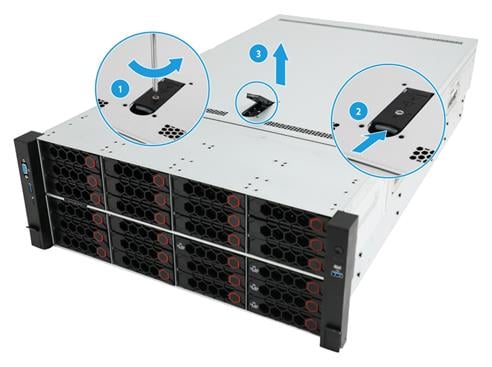
Installing the access panel
1. Open the locking lever of the access panel.
2. Install the access panel.
a. Place the access panel on top of the chassis, with the pin hole in the locking lever aligned with the guided pin on the chassis, as shown by callout 1 in Figure 16.
b. Close the locking lever. The access panel will automatically slide in place, as shown by callout 2 in Figure 16.
c. (Optional.) To lock the access panel, turn the screw on the locking lever 90 degrees, as shown by callout 3 in Figure 16.
Figure 16 Installing the access panel
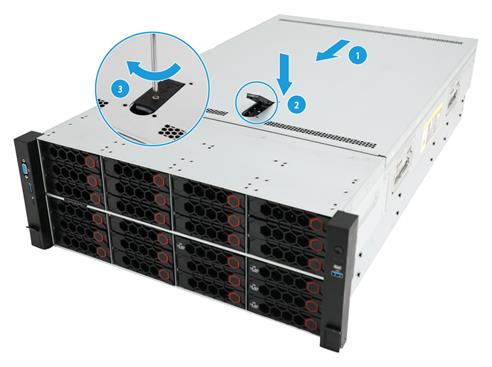
Removing the chassis air baffle
1. Open the hooks marked by blue trapezoids on the chassis air baffle, as shown by callout 1 in Figure 17.
2. Lift the air baffle out of the chassis, as shown by callout 2 in Figure 17.
Figure 17 Removing the chassis air baffle
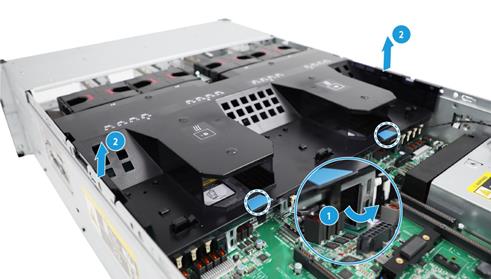
Installing the chassis air baffle
1. Align the notches on the air baffle with the pins on the chassis side panels, as shown by callout 1 in Figure 18.
2. Place the air baffle into the chassis, as shown by callout 2 in Figure 18.
3. Close the hooks marked by blue trapezoids on the chassis air baffle, as shown by callout 3 in Figure 18.
Figure 18 Installing the chassis air baffle
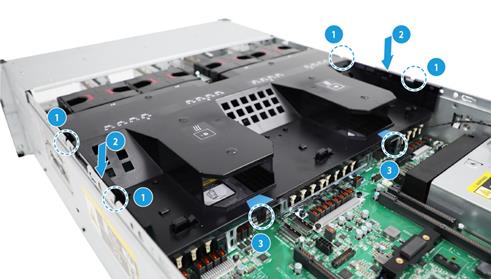
Removing the fan cage
1. Gently press the clips at the two sides of the fan cage inward, as shown by callout 1 in Figure 19.
2. Lift the fan cage out of the chassis, as shown by callout 2 in Figure 19.
Figure 19 Removing the fan cage

Installing the fan cage
Gently place the fan cage into the chassis, as shown in Figure 20.
Figure 20 Installing the fan cage
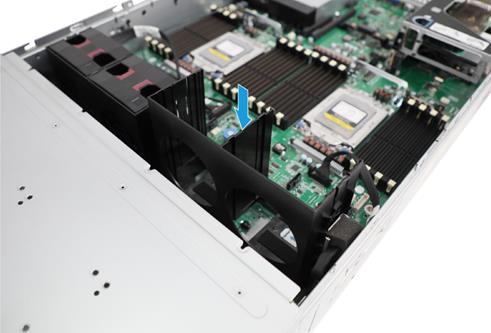
Removing the T-shape bracket
1. Use a T15 Torx screwdriver to remove the two screws that secure the T-shape bracket, as shown by callout 1 in Figure 21.
2. Lift the T-shape bracket out of the chassis, as shown by callout 2 in Figure 21.
Figure 21 Removing the T-shape bracket
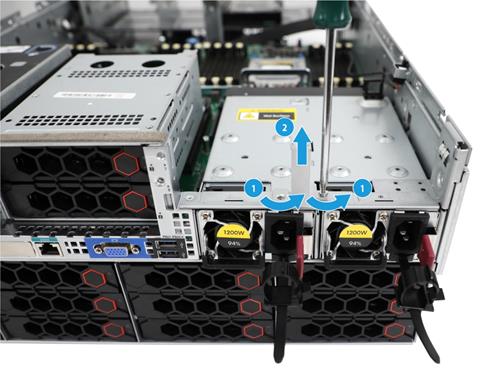
Installing the T-shape bracket
1. Place the T-shape bracket onto the chassis, with screw holes in the bracket aligned with screw holes in the chassis, as shown by callout 1 in Figure 22.
2. Use a T15 Torx screwdriver to fasten the two screws and secure the bracket into the chassis, as shown by callout 2 in Figure 22.
Figure 22 Installing the T-shape bracket
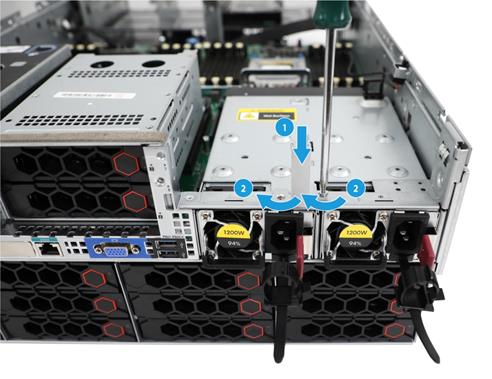
Removing the blank above the power supplies
Hold both ends of the blank and pull it out of the chassis, as shown in Figure 23.
Figure 23 Removing the blank above the power supplies
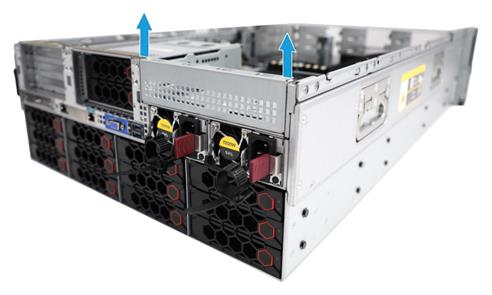
Installing the blank above the power supplies
Insert the blank into the chassis along the guide rails until the blank is fully seated, as shown in Figure 24.
Figure 24 Installing the blank above the power supplies

Removing the riser card blank over PCIe riser connector 1 or 2
The blank removal procedure is the same for PCIe riser connector 1 and connector 2. This section removes the blank over connector 1 as an example.
To remove the riser card blank, remove the two screws that secure the blank, and pull the blank out of the chassis, as shown by callouts 1 and 2 in Figure 25.
Figure 25 Removing the riser card blank over PCIe riser connector 1
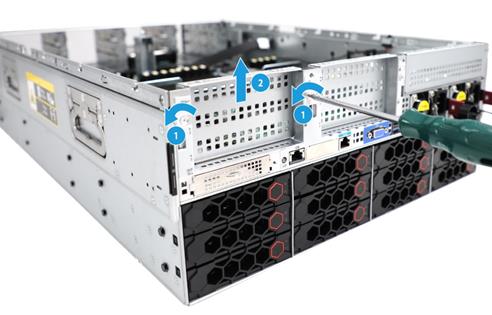
Installing the riser card blank over PCIe riser connector 1 or 2
The blank installation procedure is the same for PCIe riser connector 1 and connector 2. This section installs the blank over connector 1 as an example.
To install the riser card blank, insert the blank into the chassis over PCIe riser connector 1, and then fasten the two screws that secure the blank, as shown in Figure 26.
Figure 26 Installing the riser card blank over PCIe riser connector 1

Removing the riser card blank over PCIe riser connector 3 or 4
The blank removal procedure is the same for PCIe riser connector 3 and connector 4. This section installs the blank over connector 4 as an example.
To remove the riser card blank, lift the blank out of the chassis, as shown in Figure 27.
Figure 27 Removing the riser card blank over PCIe riser connector 4
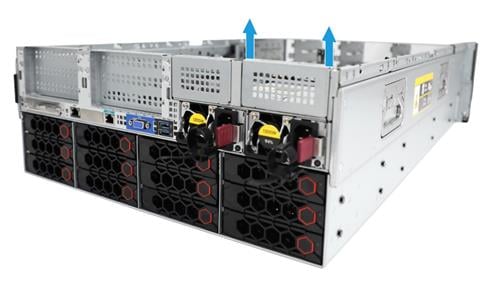
Installing the riser card blank over PCIe riser connector 3 or 4
The blank installation procedure is the same for PCIe riser connector 3 and connector 4. This section installs the blank over connector 4 as an example.
To install the riser card blank, insert the blank into the chassis along the guide rails until the blank is fully seated, as shown in Figure 28.
Figure 28 Installing the riser card blank over PCIe riser connector 4
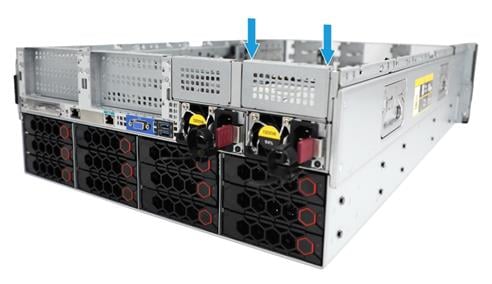
Removing a power supply blank
Hold the blank by the holes with two fingers, and then pull the blank out of the chassis, as shown in Figure 29.
Figure 29 Removing a power supply blank

Installing a power supply blank
Place the power supply blank with the TOP sign facing up, hold the blank by the holes with two fingers, and insert the blank into the slot until you cannot push it any further, as shown in Figure 30.
Figure 30 Installing a power supply blank

Removing a PCIe module blank
Pull the PCIe module blank out of the riser card, as shown in Figure 31.
Figure 31 Removing a PCIe module blank
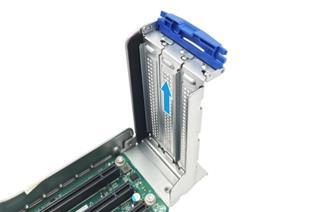
Installing a PCIe module blank
Install a PCIe module blank over an empty PCIe slot.
To install a PCIe module blank:
1. Insert the PCIe module blank into the riser card, as shown by callout 1 in Figure 32.
2. Snap the blank tail to insert the standout on the riser card into the blank notch to secure the blank, as shown by callout 2 in Figure 32.
Figure 32 Installing a PCIe module blank
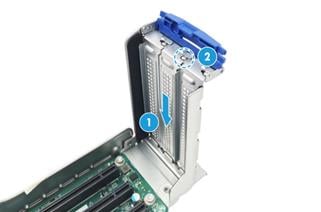
Removing the blank from the OCP network adapter slot
Hold the handle on the blank, and pull the blank out of the chassis, as shown in Figure 33.
Figure 33 Removing the blank from the OCP network adapter slot

Installing the blank to the OCP network adapter slot
Hold the handle on the blank, and insert the blank into the slot until you cannot push it any further, as shown in Figure 34.
Figure 34 Installing the blank to the OCP network adapter slot
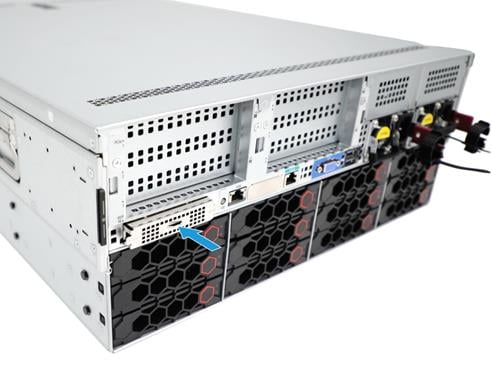
Replacing the intelligent security bezel
Guidelines
The intelligent security bezel is hot swappable.
Prerequisites
Take the following ESD prevention measures:
· Wear antistatic clothing.
· Wear an ESD wrist strap and make sure it makes good skin contact and is reliably grounded.
· Do not wear any conductive objects, such as jewelry or watches.
When you replace a component, examine the slot and connector for damages. Make sure the pins are not damaged (bent for example) and do not contain any foreign objects.
Removing the intelligent security bezel
1. Unlock the intelligent security bezel. Insert the key into the lock and press and turn the key 90 degree clockwise, as shown in Figure 35.
|
CAUTION: To avoid damage to the lock, hold down the key while you are turning the key. |
Figure 35 Unlocking the intelligent security bezel
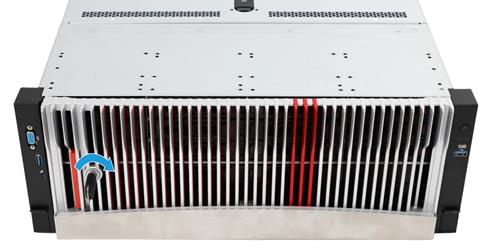
2. Press the latch and open the security bezel. Then, pull the right edge of the bezel out of the groove in the right chassis ear to remove the security bezel, as shown in Figure 36.
Figure 36 Removing the intelligent security bezel
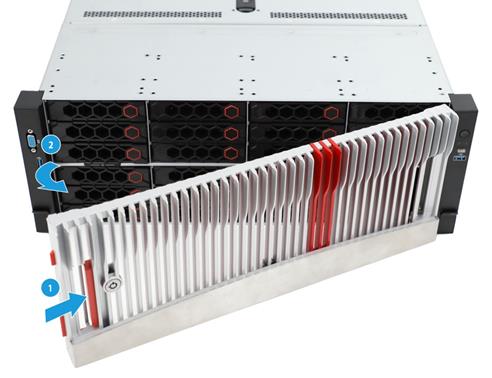
Installing the intelligent security bezel
1. Press the right edge of the security bezel into the groove in the right chassis ear. Press the latch at the other end and close the bezel, as shown in Figure 37.
Figure 37 Installing the intelligent security bezel
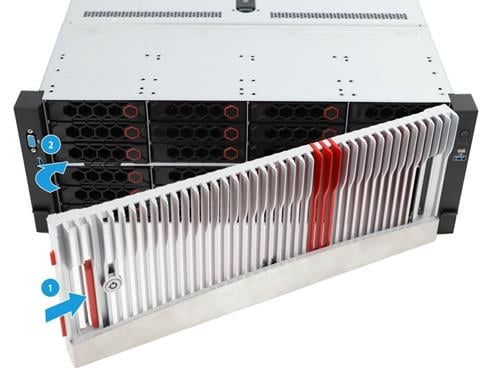
2. Lock the security bezel. Insert the key into the lock, press and turn the key 90 degree anticlockwise, and the pull out the key, as shown in Figure 38.
|
CAUTION: To avoid damage to the lock, hold down the key while you are turning the key. |
Figure 38 Locking the intelligent security bezel
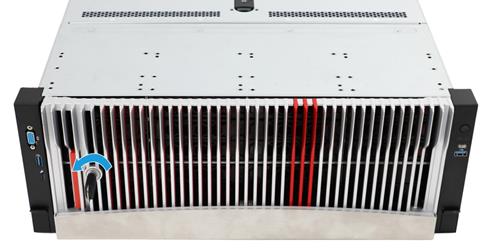
Adding a processor
For information about how to add a processor, see H3C UniServer R4300 G5 Server Processor Installation Quick Start.
Replacing a processor
|
WARNING! To avoid bodily injury from hot surfaces, allow the server and its internal modules to cool before touching them. |
Guidelines
· You can install one or two processors.
· To avoid damage to a processor or the system board, only H3C authorized or professional server engineers can install, replace, or remove a processor.
· Make sure the processors on the server are the same model.
· Each processor model string contains a suffix to differentiate processor features. For example, for the UN-CPU-INTEL-8360Y-S processor, the suffix is Y. The suffix U represents that you can only install only one processor.
For more information about compatible processors with the server, use the query tool at http://www.h3c.com/cn/Service/Document_Software/Document_Center/Server/. For more information about processor model suffixes, see Appendix A Specifications and Support Information.
· The pins in the processor sockets are very fragile and prone to damage. Install a protective cover if a processor socket is empty.
· For the server to operate correctly, make sure processor 1 is in position. For more information about processor locations, see Appendix A Specifications and Support Information.
· Different processors might have different heatsinks, but the processor replacement procedure is the same.
· You must paste the barcode label shipped with the processor to the side of the heatsink to cover the original barcode label on the heatsink. This ensures that H3C will provide the warranty service for the processor.
Prerequisites
Take the following ESD prevention measures:
· Wear antistatic clothing.
· Wear an ESD wrist strap and make sure it makes good skin contact and is reliably grounded.
· Do not wear any conductive objects, such as jewelry or watches.
· When you replace a component, examine the slot and connector for damages. Make sure the pins are not damaged (bent for example) and do not contain any foreign objects.
Removing a processor
1. Power off the server. For more information, see "Powering off the server."
2. Remove the server from the rack. For more information, see "Removing the server from a rack."
3. Remove the access panel. For more information, see "Removing the access panel."
4. Remove the chassis air baffle. For more information, see "Removing the chassis air baffle."
5. Remove the processor heatsink:
a. Loosen the four captive screws in a diagonal sequence, as shown in Figure 39.
Figure 39 Loosening captive screws on the heatsink
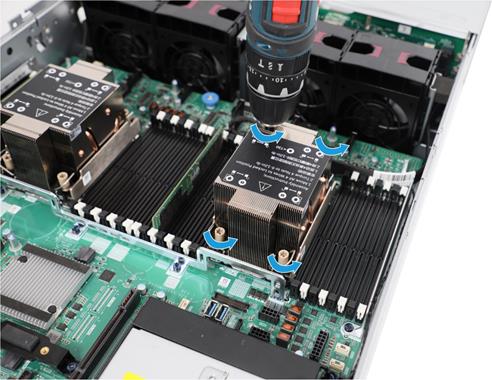
b. Open heatsink clips at the four corners, as shown in Figure 40.
Figure 40 Opening the clips to unlock the heatsink
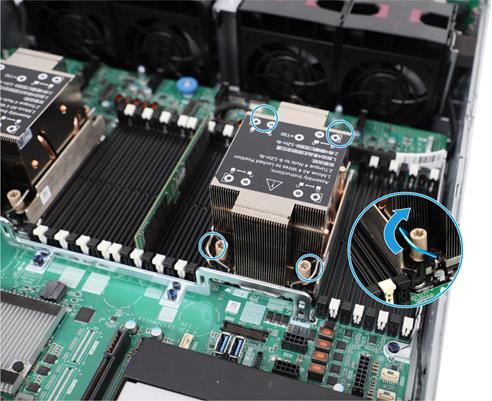
c. Lift the heatsink slowly to remove it, as shown in Figure 41.
|
CAUTION: The pins on the processor socket are very fragile. Never touch the pins. Any damage to them might require system board replacement. |
Figure 41 Lifting the heatsink
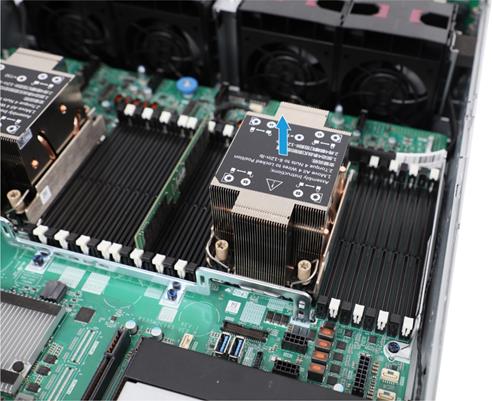
6. Remove the processor:
a. Lift the locking lever to release the processor, as shown by callout 1 in Figure 42.
b. Hold the processor and pull it out from the retaining bracket, as shown by callout 2 in Figure 42.
Figure 42 Removing the processor
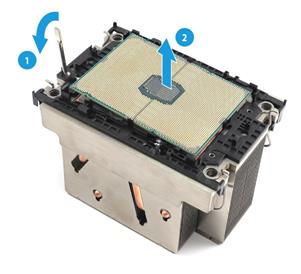
7. Remove the processor retaining bracket from the heatsink:
a. Release the four corner clips of the retaining bracket from the heatsink. Press the four clips on the retaining bracket outward, as shown by callout 1 in Figure 43.
b. Lift the retaining bracket to remove it from the heatsink, as shown by callout 2 in Figure 43.
Figure 43 Removing the retaining bracket

8. Use isopropanol wiping cloth to clear the residual thermal grease from the processor top and heatsink, as shown in Figure 44.
Figure 44 Clearing the residual thermal grease
Installing a processor
1. Install the retaining bracket onto the heatsink:
a. Close the ejector lever on the retaining bracket for secure installation of the processor.
b. Align the alignment triangle on the retaining bracket with the cut-off corner of the heatsink. Place the bracket on top of the heatsink, with the four corners of the bracket clicked into the four corners of the heatsink, as shown in Figure 45.
For the processor to be installed correctly, make sure the locking lever on the retaining bracket is closed as shown in Figure 46.
Figure 45 Installing the retaining bracket onto the heatsink
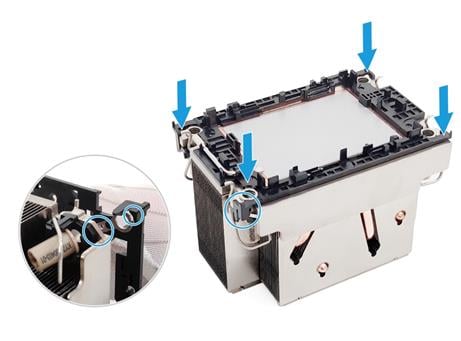
Figure 46 Locking lever opened or closed on the retaining bracket
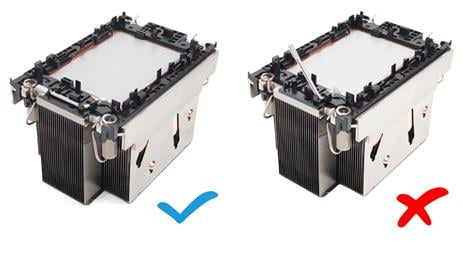
2. Smear thermal grease onto the processor:
a. Clean the heatsink. Make sure no thermal grease remains on the heatsink top.
b. Use the thermal grease injector to inject 0.6 ml of thermal grease to the five dots on the processor, 0.12 ml for each dot, as shown in Figure 47.
Figure 47 Smearing thermal grease onto the processor
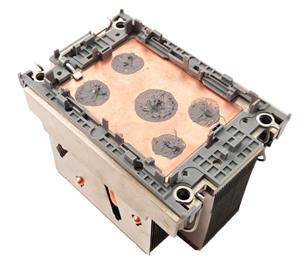
3. Install the processor onto the retaining bracket.
|
CAUTION: To avoid damage to the processor, always hold the processor by its edges. Never touch the gold contacts on the processor bottom. |
a. Tilt the processor and align the small triangle on the processor with the alignment triangle on the retaining bracket.
b. Press one side of the processor against a retention clip on the retaining bracket.
c. Use two thumbs to push the other side of the processor and place the processor onto the retaining bracket.
Figure 48 Installing the processor onto the retaining bracket

d. Open the retention clips on the retaining bracket to lock the processor in place.
Figure 49 Locking the processor

4. Install the heatsink onto the server:
a. Align the alignment triangle on the retaining bracket with the cut-off corner of the processor socket and the pin holes in the heatsink with the guide pins on the processor socket. Lower down the heatsink on the processor socket.
|
CAUTION: To avoid damages to the heatsink fins, hold the heatsink in the correct way as shown in Figure 51. |
Figure 50 Attaching the heatsink to the processor socket

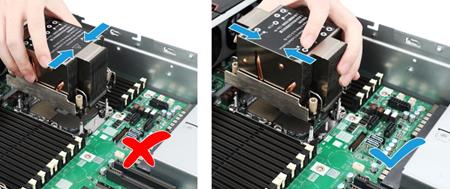
b. Press down the heatsink clips at the four corners to lock the heatsink in place.
Figure 52 Locking the heatsink
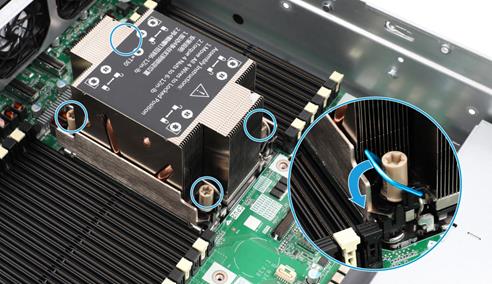
c. Use a T30 Torx screwdriver to fasten the four captive screws on the heatsink in a diagonal sequence.
|
CAUTION: To avoid poor contact between the processor and the system board or damage to the pins in the processor socket, tighten the screws to a torque value of 0.9 Nm (8 in-lbs).. |
Figure 53 Fastening the captive screws
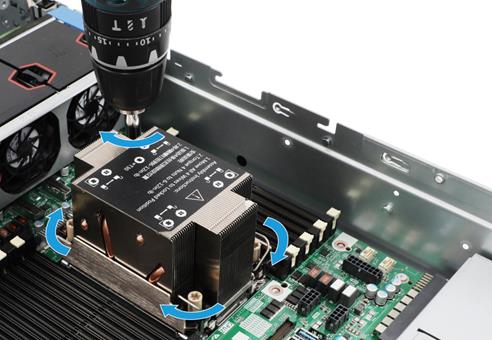
5. Install the chassis air baffle. For more information, see "Installing the chassis air baffle."
6. Install the access panel. For more information, see "Installing the access panel."
7. Rack-mount the server. For more information, see "Rack-mounting the server."
8. Connect the power cord. For more information, see "Connecting the power cord."
9. Power on the server. For more information, see "Powering on the server."
Verifying the replacement
Log in to HDM and view the operating status of the processor to verify that the processor is operating correctly. For more information, see the HDM online help.
Replacing a DIMM
|
WARNING! To avoid bodily injury from hot surfaces, allow the server and its internal modules to cool before touching them. |
About DIMMs
The server supports DDR4 and PMem 200 DIMMs. Compared with DDR4 DIMMs, PMem 200 DIMMs provide larger capacity and can protect data from getting lost in case of unexpected system power outage.
DDR4 DIMMs include LRDIMM and RDIMM.
· RDIMMs can perform parity check on addresses.
· Compared with RDIMMs, LRDIMMs provide larger capacity and higher bandwidth.
Both DDR4 and PMem 200 DIMMs are referred to as DIMMs in this document, unless otherwise stated.
Guidelines
The server provides eight DIMM channels per processor and each channel has two DIMM slots. If the server has one processor, the total number of DIMM slots is 16. If the server has two processors, the total number of DIMM slots is 32.
You can install only DDR4 DIMMs on the server or install both PMem 200 and DDR4 DIMMs on the server.
For PMem 200 DIMMs to operate correctly, make sure the PMem 200 firmware is compatible with the BIOS version. For more information, see the corresponding BIOS release notes.
When you install a DIMM, use Table 8 to verify that it is compatible with the processors.
Table 8 DIMM and processor compatibility
|
Processor |
Memory type @ frequency |
|
Intel Ice Lake |
· DDR4 @ 3200MHz · PMem 200 @ 2666MHz |
|
|
NOTE: · The number of DIMMs installed in a channel does not affect the DIMM frequency. Each channel supports a maximum of two DIMMs. · If the frequency of a processor is lower than the frequency of a connected DIMM, the DIMM operates at the processor frequency. For example, for a DDR4 DIMM to operate at 3200 MHz, you must also use a processor that can operate at 3200 MHz. For the frequency of a DIMM or processor, use the query tool at http://www.h3c.com/cn/Service/Document_Software/Document_Center/Server/ to filter information by DIMM name or processor name. |
Guidelines for installing only DDR4 DIMMs
When you install only DDR4 DIMMs, follow these restrictions and guidelines:
· Make sure their corresponding processors are present before powering on the server.
· Make sure all DDR4 DIMMs installed on the server have the same product code. For information about DIMM product codes, use the query tool available from http://www.h3c.com/cn/Service/Document_Software/Document_Center/Server/.
· For the configured memory mode to take effect, make sure the following installation requirements are met:
|
Memory mode |
DIMM population requirements |
|
Independent |
· If one processor is present, see Figure 54. · If two processors are present, see Figure 55. |
|
Mirror |
· A minimum of two DIMMs for a processor. · Strictly follow the DIMM installation schemes for installing a minimum of two DIMMs per processor. ¡ If one processor is present, see Figure 54. ¡ If two processors are present, see Figure 55 |
|
|
NOTE: · If the DIMM configuration does not meet the requirements for the configured memory mode, the system uses the default memory mode (Independent mode). · In Figure 54 and Figure 55, the black DIMM slots (for example, the F1 slot) are grey colored, and the white DIMM slots (for example, the F0 slot) are not colored. |
Figure 54 DDR4-only DIMM population schemes for one processor
Figure 55 DDR4-only DIMM population schemes for two processors
Guidelines for installing a mixture of PMem 200 and DDR4 DIMMs
When you install PMem 200 and DDR4 DIMMs on the server, follow these restrictions and guidelines:
· Make sure their corresponding processors are present before powering on the server.
· Make sure the PMem 200 DIMMs have never been used on any other products. If they have been used on any other products, they might be unusable on the server.
· Make sure all DDR4 DIMMs have the same product code and all PMem DIMMs have the same product code. For information about DIMM product codes, use the query tool available from http://www.h3c.com/cn/Service/Document_Software/Document_Center/Server/.
· Depending on the processor and DIMM configuration, use the schemes shown in Figure 56, Figure 57, and Figure 58 to populate the DIMM slots.
|
|
NOTE: In Figure 56, Figure 57, and Figure 58, the black DIMM slots (for example, the F1 slot) are grey colored, and the white DIMM slots (for example, the F0 slot) are not colored. |
If one processor is present, populate DIMMs as shown in Figure 56.
Figure 56 Mixed DDR4 and PMem DIMM population schemes for one processor
If two processors are present, populate DIMMs as shown in Figure 57 or Figure 58.
Figure 57 Mixed DDR4 and PMem DIMM population schemes for two processors (1)
Figure 58 Mixed DDR4 and PMem DIMM population schemes for two processors (2)
Prerequisites
Take the following ESD prevention measures:
· Wear antistatic clothing.
· Wear an ESD wrist strap and make sure it makes good skin contact and is reliably grounded.
· Do not wear any conductive objects, such as jewelry or watches.
When you replace a component, examine the slot and connector for damages. Make sure the pins are not damaged (bent for example) and do not contain any foreign objects.
Removing a DIMM
1. Power off the server. For more information, see "Powering off the server."
2. Remove the server from the rack. For more information, see "Removing the server from a rack."
3. Remove the access panel. For more information, see "Removing the access panel."
4. Remove the chassis air baffle. For more information, see "Removing the chassis air baffle."
5. Open the DIMM slot latches and pull the DIMM out of the slot to remove the DIMM, as shown in Figure 59.
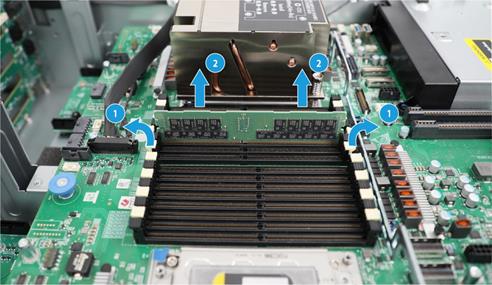
Installing a DIMM
1. Install the DIMM. Align the notch on the DIMM with the connector key in the DIMM slot and press the DIMM into the socket until the latches lock the DIMM in place, as shown in Figure 60.

2. Install the chassis air baffle. For more information, "Installing the chassis air baffle."
3. Install the access panel. For more information, see "Installing the access panel."
4. Rack-mount the server. For more information, see "Rack-mounting the server."
5. Connect the power cord. For more information, see "Connecting the power cord."
6. Power on the server. For more information, see "Powering on the server."
7. (Optional.) Access the BIOS to change the memory mode, if necessary. For more information, see the BIOS user guide for the server.
Verifying the replacement
Use one of the following methods to verify that the DIMM is installed correctly:
· Using the operating system:
¡ In Windows, select Run in the Start menu, enter msinfo32, and verify the memory capacity of the DIMM.
¡ In Linux, execute the cat /proc/meminfo command to verify the memory capacity.
· Using HDM:
Log in to HDM and verify the memory capacity of the DIMM. For more information, see the HDM online help.
· Using BIOS:
Access the BIOS, select Socket Configuration > Memory Configuration > Memory Topology, and press Enter. Then, verify the memory capacity of the DIMM.
If the memory capacity displayed is inconsistent with the actual capacity, remove and then reinstall the DIMM, or replace the DIMM with a new DIMM.
If the DIMM is in Mirror mode, it is normal that the displayed capacity is smaller than the actual capacity.
Replacing the system board
Guidelines
|
WARNING! To avoid bodily injury from hot surfaces, allow the server and its internal modules to cool before touching them. |
To prevent electrostatic discharge, place the removed parts on an antistatic surface or in antistatic bags.
Prerequisites
Take the following ESD prevention measures:
· Wear antistatic clothing.
· Wear an ESD wrist strap and make sure it makes good skin contact and is reliably grounded.
· Do not wear any conductive objects, such as jewelry or watches.
When you replace a component, examine the slot and connector for damages. Make sure the pins are not damaged (bent for example) and do not contain any foreign objects.
Removing the system board
1. Power off the server. For more information, see "Powering off the server."
2. Remove the server from the rack. For more information, see "Removing the server from a rack."
3. Remove the OCP network adapter. For more information, see "_Ref89848754."
4. Remove the power supplies. For more information, see "Removing a power supply."
5. Remove the access panel. For more information, see "Removing the access panel."
6. Remove the chassis air baffle. For more information, see "Removing the chassis air baffle."
7. Remove all the fan modules. For more information, see "Removing a fan module."
8. Remove the fan cage. For more information, see "Removing the fan cage."
9. Disconnect all cables from the system board.
10. Remove all components installed on the system board, for example, riser cards, DIMMs, and processors.
11. Install protective covers over empty processor sockets.
Figure 61 Installing a protective cover over an empty processor socket

12. Remove the system board:
a. Loosen the two captive screws on the system board, as shown by callout 1 in Figure 62.
b. Hold the system board handle and slide the system board toward the server front to disengage onboard connectors (for example, USB connectors and Ethernet ports) from the chassis. Then, lift the system board to remove it from the chassis, as shown by callout 2 in Figure 62.
Figure 62 Removing the system board

Installing the system board
1. Install the system board:
a. Hold the system board handle and slowly place the system board in the chassis. Then, slide the system board toward the server rear until the connectors (for example, USB connectors and the Ethernet port) on it are securely seated, as shown by callout 1 in Figure 63.
|
|
NOTE: The connectors are securely seated if you cannot use the system board handle to lift the system board. |
b. Fasten the two captive screws on the system board, as shown by callout 2 in Figure 63.
Figure 63 Installing the system board

2. Reconnect cables to the system board.
3. Remove the installed protective covers over the processor sockets. Hold a cover by the standouts at the two ends and lift it straight up and away from a socket, as shown in Figure 64.
Keep the cover for future use.
Figure 64 Removing the protective cover over a processor socket

4. Install the removed components (for example, riser cards, DIMMs, and GPUs) on the system board.
5. Install the removed fan cage. For more information, see "Installing the fan cage."
6. Install the fan modules. For more information, see "Installing a fan module."
7. Install the chassis air baffle. For more information, see "Installing the chassis air baffle."
8. Install the access panel. For more information, see "Installing the access panel."
9. Install the removed OCP network adapter. For more information, see "_Ref89850977."
10. Install the removed power supplies. For more information, see "Installing a power supply."
11. Rack-mount the server. For more information, see "Rack-mounting the server."
12. Connect the power cord. For more information, see "Connecting the power cord."
13. Power on the server. For more information, see "Powering on the server."
Replacing a SAS/SATA drive
The drives are hot swappable.
To configure RAID settings after the drive is replaced, see the storage controller user guide for the server.
Guidelines
The drives are hot swappable. If you hot swap an HDD repeatedly within 30 seconds, the system might fail to identify the drive.
If you are using the drives to create a RAID, follow these restrictions and guidelines:
· To avoid degraded RAID performance or RAID creation failures, make sure all drives in the RAID are the same type (HDDs or SSDs) and have the same connector type (SAS or SATA).
· For efficient use of storage, use drives that have the same capacity to build a RAID. If the drives have different capacities, the lowest capacity is used across all drives in the RAID.
· If one drive is used by several logical drives, RAID performance might be affected and maintenance complexities will increase.
· If the installed drive contains RAID information, you must clear the information before configuring RAIDs. As a best practice, install drives that do not contain RAID information.
Prerequisites
Take the following ESD prevention measures:
· Wear antistatic clothing.
· Wear an ESD wrist strap and make sure it makes good skin contact and is reliably grounded.
· Do not wear any conductive objects, such as jewelry or watches.
When you replace a component, examine the slot and connector for damages. Make sure the pins are not damaged (bent for example) and do not contain any foreign objects.
Identify the position of the drive to be replaced.
Identify the RAID array information of the drive to be replaced. To replace a drive in a non-redundancy RAID array, back up data in the RAID array if the old drive is full or the new drive is of a different model.
Removing a SAS/SATA drive
1. Remove the security bezel, if any. For more information, see "Removing the intelligent security bezel."
2. Observe the drive LEDs to verify that the drive is not selected by the storage controller and is not performing a RAID migration or rebuilding. For more information about drive LEDs, see Appendix A Specifications and Support Information.
3. Remove the drive, as shown in Figure 65:
¡ To remove an SSD, press the button on the drive panel to release the locking lever, and then hold the locking lever and pull the drive out of the slot.
¡ To remove an HDD, press the button on the drive panel to release the locking lever. Pull the drive 3 cm (1.18 in) out of the slot. Wait for a minimum of 30 seconds for the drive to stop rotating, and then pull the drive out of the slot.

4. Remove the drive carrier. Remove the screws that secure the drive and then remove the drive from the carrier, as shown in Figure 66.
Figure 66 Removing the drive carrier

Installing a SAS/SATA drive
|
IMPORTANT: As a best practice, install drives that do not contain RAID information. |
1. Attach the drive to the drive carrier. Place the drive in the carrier and then use four screws to secure the drive into place, as shown in Figure 67.
Figure 67 Attaching the drive to the drive carrier
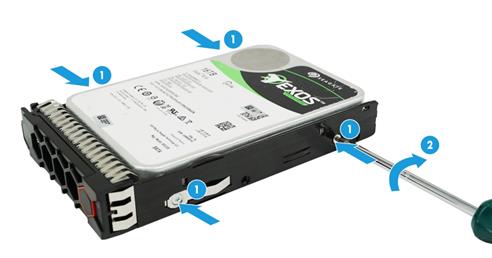
2. Install the drive.
a. Press the button on the drive panel to release the locking lever, as shown in Figure 68.
Figure 68 Releasing the locking lever

3. Insert the drive into the slot and push it gently until you cannot push it further. Then, close the locking lever. See Figure 69.
Figure 69 Installing the drive
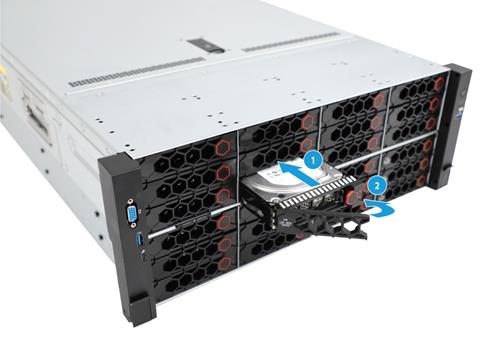
4. Install the security bezel, if any. For more information, see "Installing the intelligent security bezel."
Verifying the replacement
Use one of the following methods to verify that the drive has been replaced correctly:
· Verify the drive properties (including capacity) by using one of the following methods:
¡ Log in to HDM. For more information, see H3C Servers HDM online help.
¡ Access the BIOS. For more information, see the storage controller user guide for the server.
¡ Access the CLI or GUI of the server.
· Observe the drive LEDs to verify that the drive is operating correctly. For more information about drive LEDs, see Appendix A Specifications and Support Information.
Adding an NVMe drive
Guidelines
Support for hot insertion of NVMe drives varies by operating system. For compatibility with the operating systems, visit the query tool at http://www.h3c.com/cn/Service/Document_Software/Document_Center/Server/.
If an operating system supports hot swapping of NVMe drives, follow these guidelines:
· Insert NVMe drives steadily without pauses to prevent the operating system from being stuck or restarted.
· Do not hot swap multiple NVMe drives at the same time. As a best practice, hot swap NVMe drives one after another at intervals longer than 30 seconds. After the operating system identifies the first NVMe drive, you can hot swap the next drive. If you insert multiple NVMe drives simultaneously, the system might fail to identify the drives.
If you are using the drives to create a RAID, follow these restrictions and guidelines:
· For efficient use of storage, use drives that have the same capacity to build a RAID. If the drives have different capacities, the lowest capacity is used across all drives in the RAID. A drive with extra capacity cannot be used to build other RAIDs.
· As a best practice, install drives that do not contain RAID information. If the installed drive contains RAID information, you must clear the information before configuring RAIDs. For more information, see the storage controller user guide for the server.
Prerequisites
Take the following ESD prevention measures:
· Wear antistatic clothing.
· Wear an ESD wrist strap and make sure it makes good skin contact and is reliably grounded.
· Do not wear any conductive objects, such as jewelry or watches.
When you replace a component, examine the slot and connector for damages. Make sure the pins are not damaged (bent for example) and do not contain any foreign objects.
Identify the position of the drive to be replaced.
Identify the RAID array information for the drive to be replaced. To replace a drive in a non-redundancy RAID array, back up data in the RAID array if the old drive is full or the new drive is of a different model.
Installing an NVMe drive
1. Remove the security bezel, if any. For more information, see "Removing the intelligent security bezel."
2. Install the drive into the drive carrier. Secure the four screws into the screw holes, and then fasten the screws tightly in sequence.
3. Install an NVMe drive.
¡ If the operating system supports hot insertion of NVMe drives, see NVMe Drives Online Replacement User Guide.
¡ If the operating system does not support hot insertion of NVMe drives, proceed to the next step.
4. Power off the server. For more information, see "Powering off the server."
5. Push the drive into the drive slot, and close the locking lever on the drive panel.
6. Install the security bezel, if any. For more information, see "Installing the intelligent security bezel."
Verifying the installation
Use one of the following methods to verify that the drive has been installed correctly:
· Verify the drive properties (including capacity) by using one of the following methods:
¡ Log in to HDM. For more information, see H3C Servers HDM online help.
¡ Access the BIOS. For more information, see the BIOS user guide for the server.
¡ Access the CLI or GUI of the server.
· Observe the drive LEDs to verify that the drive is operating correctly. For more information about drive LEDs, see Appendix A Specifications and Support Information.
Replacing an NVMe drive
Guidelines
Support for hot insertion and managed hot removal of NVMe drives varies by operating system. For compatibility with the operating systems, visit the query tool at http://www.h3c.com/cn/Service/Document_Software/Document_Center/Server/. To replace an NVMe drive in an operating system that does not support hot insertion or managed hot removal of NVMe drives, first power off the server.
If an operating system supports hot swapping of NVMe drives, follow these guidelines:
· Insert NVMe drives steadily without pauses to prevent the operating system from being stuck or restarted.
· Do not hot swap multiple NVMe drives at the same time. As a best practice, hot swap NVMe drives one after another at intervals longer than 30 seconds. After the operating system identifies the first NVMe drive, you can hot swap the next drive. If you insert multiple NVMe drives simultaneously, the system might fail to identify the drives.
If you are using the drives to create a RAID, follow these restrictions and guidelines:
· For efficient use of storage, use drives that have the same capacity to build a RAID. If the drives have different capacities, the lowest capacity is used across all drives in the RAID. A drive with extra capacity cannot be used to build other RAIDs.
· As a best practice, install drives that do not contain RAID information. If the installed drive contains RAID information, you must clear the information before configuring RAIDs. For more information, see the storage controller user guide for the server.
Prerequisites
Take the following ESD prevention measures:
· Wear antistatic clothing.
· Wear an ESD wrist strap and make sure it makes good skin contact and is reliably grounded.
· Do not wear any conductive objects, such as jewelry or watches.
When you replace a component, examine the slot and connector for damages. Make sure the pins are not damaged (bent for example) and do not contain any foreign objects.
Identify the position of the drive to be replaced.
Identify the RAID array information for the drive to be replaced. To replace a drive in a non-redundancy RAID array, back up data in the RAID array if the old drive is full or the new drive is of a different model.
Removing an NVMe drive
1. Remove the security bezel, if any. For more information, see "Removing the intelligent security bezel."
2. Identify if the operating system supports hot removal or managed hot removal of NVMe drives.
¡ If the operating system does not support hot removal or managed hot removal of NVMe drives, power off the server and then proceed to the next step. For more information, see "Powering off the server."
¡ If the operating system supports hot removal or managed hot removal of NVMe drives, see NVMe Drives Online Replacement User Guide.
a. Press the button on the drive panel to release the locking lever, as shown by callout 1 in Figure 70.
b. Pull the drive out of the slot, as shown by callout 2 in Figure 70.

4. Remove the drive carrier. Remove the screws that secure the drive and then remove the drive from the carrier, as shown in Figure 71.
Figure 71 Removing the drive carrier
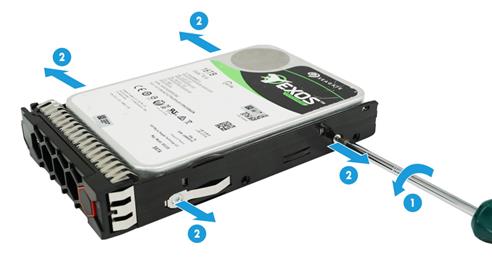
Installing an NVMe drive
1. Identify if the operating system supports hot insertion of NVMe drives.
¡ If the operating system does not support hot insertion of NVMe drives, power off the server and then proceed to the next step. For more information, see "Powering off the server."
¡ If the operating system supports hot insertion of NVMe drives, see NVMe Drives Online Replacement User Guide.
2. Attach the drive to the drive carrier. Place the drive in the carrier and then use four screws to secure the drive into place, as shown in Figure 72.
Figure 72 Attaching the drive to the drive carrier

3. Install the drive:
a. Press the button on the drive panel to release the locking lever, as shown in Figure 73.
Figure 73 Releasing the locking lever
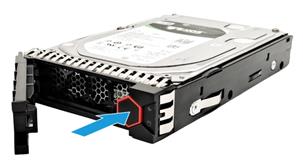
4. Insert the drive into the slot and push it gently until you cannot push it further. Then, click the locking lever. See Figure 74.
Figure 74 Installing the drive

5. Install the removed security bezel, if any. For more information, see "Installing the intelligent security bezel."
6. Power on the server. For more information, see "Powering on the server."
Verifying the replacement
Use the following methods to verify that the drive is installed correctly:
· Verify the drive properties (including capacity) by using one of the following methods:
¡ Access HDM. For more information, see HDM online help.
¡ Access the BIOS. For more information, see the BIOS user guide for the server.
¡ Access the CLI or GUI of the server.
· Observe the drive LEDs to verify that the drive is operating correctly. For more information, see Appendix A Specifications and Support Information.
Replacing a front drive backplane
Guidelines
|
WARNING! To avoid bodily injury from hot surfaces, allow the server and its internal modules to cool before touching them. |
The required Exp module firmware varies by the number of storage controllers attached to the backplane:
· If one controller is attached, use the single version firmware.
· If two controllers are attached, use the dual version firmware.
For more information about drive backplanes, see Appendix A Specifications and Support Information.
Prerequisites
Take the following ESD prevention measures:
· Wear antistatic clothing.
· Wear an ESD wrist strap and make sure it makes good skin contact and is reliably grounded.
· Do not wear any conductive objects, such as jewelry or watches.
When you replace a component, examine the slot and connector for damages. Make sure the pins are not damaged (bent for example) and do not contain any foreign objects.
Removing a front drive backplane
1. Power off the server. For more information, see "Powering off the server."
2. Remove the server from the rack. For more information, see "Removing the server from a rack."
3. Remove the drives attached to the backplane. For more information, see "Removing a SAS/SATA drive."
4. Remove the access panel. For more information, see "Removing the access panel."
5. Remove all the fan modules. For more information, see "Removing a fan module."
6. Remove the fan cage. For more information, see "Removing the fan cage."
7. Disconnect cables from the backplane.
8. Remove the front drive backplane.
a. Loosen the captive screws that secure the backplane, as shown by callout 1 in Figure 75.
b. Lift the backplane out of the chassis, as shown by callout 2 in Figure 75.
Figure 75 Removing the front drive backplane
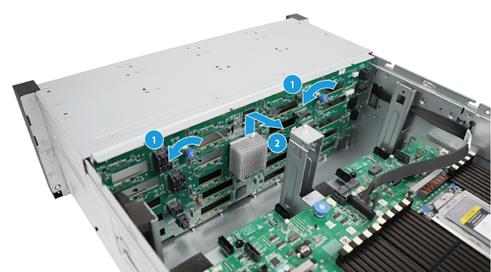
Installing a front drive backplane
1. Install a drive backplane. Place the backplane in the slot and then fasten the captive screws, as shown in Figure 76.
Figure 76 Installing a front drive backplane
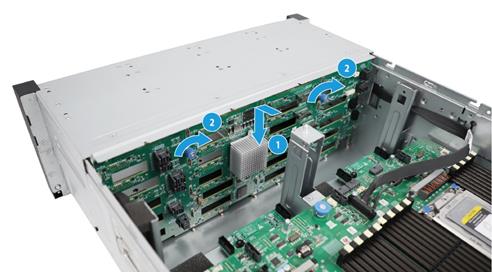
2. Connect cables to the drive backplane.
3. Install the removed fan cage. For more information, see "Installing the fan cage."
4. Install all the fan modules. For more information, see "Installing a fan module."
5. Install the access panel. For more information, see "Installing the access panel."
6. Install the removed drives. For more information, see "Installing a SAS/SATA drive."
7. Rack-mount the server. For more information, see "Rack-mounting the server."
8. Connect the power cord. For more information, see "Connecting the power cord."
9. Power on the server. For more information, see "Powering on the server."
Replacing a rear drive backplane
The server supports multiple rear drive backplanes. This section replaces a rear 2FF drive backplane as an example.
Prerequisites
Take the following ESD prevention measures:
· Wear antistatic clothing.
· Wear an ESD wrist strap and make sure it makes good skin contact and is reliably grounded.
· Do not wear any conductive objects, such as jewelry or watches.
· When you replace a component, examine the slot and connector for damages. Make sure the pins are not damaged (bent for example) and do not contain any foreign objects.
Removing a rear drive backplane
1. Power off the server. For more information, see "Powering off the server."
2. Remove the server from the rack. For more information, see "Removing the server from a rack."
3. Remove the drives attached to the backplane. For more information, see "Removing a SAS/SATA drive."
4. Remove the access panel. For more information, see "Removing the access panel."
5. Disconnect all cables from the rear drive backplane.
6. Remove the rear drive backplane as shown in Figure 77:
a. Loosen the captive screw on the rear drive backplane, as shown by callout 1.
b. Slide the drive backplane until the notch on the backplane is aligned with the guide pin on the drive cage, and pull the backplane out of the drive cage, as shown by callout 2.
Figure 77 Removing the rear drive backplane
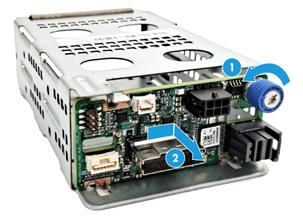
Installing a rear drive backplane
1. Install the rear drive backplane. Align the notch on the backplane with the guide pin on the drive cage, attach the backplane to the drive cage, and slide the backplane until you cannot slide it any further. Then, fasten the captive screw. See Figure 78.
Figure 78 Installing the rear drive backplane
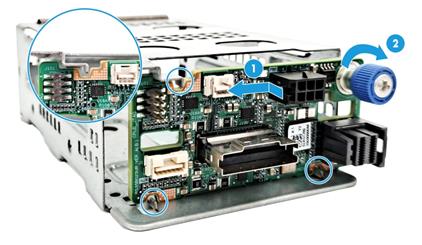
2. Connect the cables to the rear drive backplane.
3. Install the access panel. For more information, see "Installing the access panel."
4. Install the removed drives. For more information, see "Installing a SAS/SATA drive."
5. Rack-mount the server. For more information, see "Rack-mounting the server."
6. Connect the power cord. For more information, see "Connecting the power cord."
7. Power on the server. For more information, see "Powering on the server."
Replacing a rear drive cage
Prerequisites
Take the following ESD prevention measures:
· Wear antistatic clothing.
· Wear an ESD wrist strap and make sure it makes good skin contact and is reliably grounded.
· Do not wear any conductive objects, such as jewelry or watches.
When you replace a component, examine the slot and connector for damages. Make sure the pins are not damaged (bent for example) and do not contain any foreign objects.
Removing a rear drive cage
1. Power off the server. For more information, see "Powering off the server."
2. Remove the server from the rack. For more information, see "Removing the server from a rack."
3. Remove the access panel. For more information, see "Removing the access panel."
4. Disconnect all cables from the drive backplane.
5. Remove a rear drive cage:
¡ To remove a rear 2SFF drive cage, remove screws that secure the drive cage, and lift the drive cage out of the chassis.
The procedures are similar for removing a rear 2SFF drive cage and a rear 4SFF drive cage. This section removes a rear 2SFF drive cage as an example.
Figure 79 Removing a rear 2SFF drive cage

¡ Remove a rear 2LFF drive cage, remove screws that secure the drive cage, and lift the drive cage out of the chassis.
The procedures are similar for removing a rear 2LFF drive cage and a rear 4LFF drive cage. This section removes a rear 2LFF drive cage as an example.
Figure 80 Removing a 2LFF drive cage

Installing a rear drive cage
1. Install a rear drive cage:
¡ To install a rear 2SFF drive cage, press the right side of the drive cage against the chassis side panel, place the drive cage into the chassis, and use screws to secure the drive cage.
The procedures are similar for installing a rear 2SFF drive cage and a rear 4SFF drive cage. This section installs a rear 2SFF drive cage as an example.
Figure 81 Installing a rear 2SFF drive cage
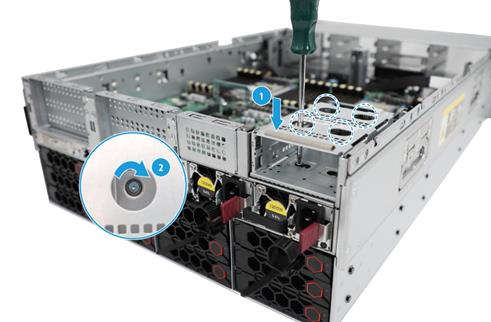
¡ To install a rear 2LFF drive cage, press the front of the drive cage against the support brackets, and place the drive cage into the chassis. Then, use screws to secure the drive cage.
The procedures are similar for installing a rear 2LFF drive cage and a rear 4LFF drive cage. This section installs a rear 2LFF drive cage as an example.
Figure 82 Installing a rear 2LFF drive cage

2. Connect cables to the drive backplane.
3. Install the access panel. For more information, see "Installing the access panel."
4. Install the removed drives. For more information, see "Installing a SAS/SATA drive."
5. Rack-mount the server. For more information, see "Rack-mounting the server."
6. Connect the power cord. For more information, see "Connecting the power cord."
7. Power on the server. For more information, see "Powering on the server."
Replacing riser cards and PCIe modules
|
WARNING! To avoid bodily injury from hot surfaces, allow the server and its internal modules to cool before touching them. |
The server provides three PCIe riser connectors on the system board to connect riser cards, which hold PCIe modules. For more information about the connector locations, see Appendix A Specifications and Support Information.
Guidelines
You can install a PCIe module in a PCIe slot for a larger-sized PCIe module. For example, an LP PCIe module can be installed in a slot for an FHFL PCIe module.
A PCIe slot can supply power to the installed PCIe module if the maximum power consumption of the module does not exceed 75 W. If the maximum power consumption exceeds 75 W, a power cord is required.
If a processor is faulty or absent, the PCIe slots connected to it are unavailable. For more information about riser card, PCIe slot, and processor mappings, see Appendix A Specifications and Support Information.
Prerequisites
Take the following ESD prevention measures:
· Wear antistatic clothing.
· Wear an ESD wrist strap and make sure it makes good skin contact and is reliably grounded.
· Do not wear any conductive objects, such as jewelry or watches.
When you replace a component, examine the slot and connector for damages. Make sure the pins are not damaged (bent for example) and do not contain any foreign objects.
Removing a riser card and a PCIe module
1. Power off the server. For more information, see "Powering off the server."
2. Remove the server from the rack. For more information, see "Removing the server from a rack."
3. Remove the access panel. For more information, see "Removing the access panel."
4. Disconnect all cables that hinder the replacement, if any.
5. Remove the riser card installed with a PCIe module. Holding the riser card by the notch and handle, lift the riser card to remove the riser card from the chassis.
The procedures are similar for removing riser cards from PCIe riser connector 1, 2, and 3. This section removes the riser card from PCIe riser connector 1 as an example.
Figure 83 Removing a riser card from PCIe riser connector 1
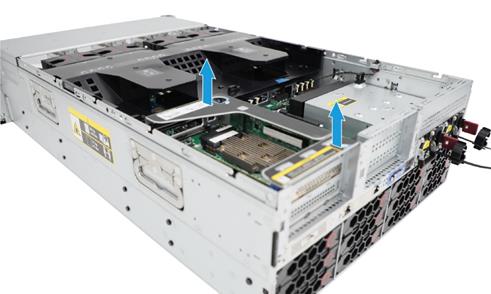
6. Remove the PCIe module from the riser card:
a. Open the retaining latch on the riser card, as shown by callout 1 in Figure 84.
b. Pull the PCIe module out of the slot, as shown by callout 2 in Figure 84.
Figure 84 Removing a PCIe module from the riser card
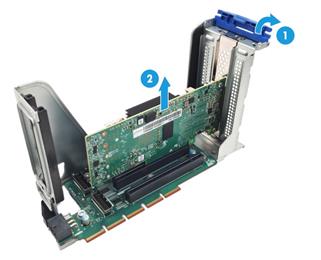
Installing a riser card and a PCIe module
1. Install a PCIe module on the riser card:
a. Insert the PCIe module into the slot on the riser card along the guide rails. Snap the module tail to insert the standout on the riser card into the blank notch in the tail to secure the module, as shown by callout 1 in Figure 85..
b. Close the retaining latch on the riser card, as shown by callout 2 in Figure 85.
Figure 85 Installing a PCIe module onto the riser card
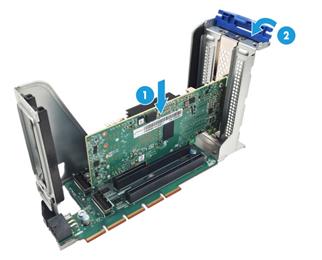
2. Install the riser card on the server:
a. Remove the riser card blank. For more information, see "Removing the riser card blank over PCIe riser connector 1 or 2" or "Removing the riser card blank over PCIe riser connector 3 or 4."
b. Install the riser card on the PCIe riser connector, with the two standouts on the card aligned with the notches in the chassis, as shown in Figure 86.
Figure 86 Installing the riser card

3. Connect cables to the riser card or PCIe modules, if any.
4. Install the access panel. For more information, see "Installing the access panel."
5. Rack-mount the server. For more information, see "Rack-mounting the server."
6. Connect the power cord. For more information, see "Connecting the power cord."
7. Power on the server. For more information, see "Powering on the server."
Replacing a storage controller and a power fail safeguard module
|
WARNING! To avoid bodily injury from hot surfaces, allow the server and its internal modules to cool before touching them. |
For some storage controllers, you can order a power fail safeguard module to prevent data loss when power outage occurs.
A power fail safeguard module provides a flash card and a supercapacitor. When a system power failure occurs, this supercapacitor can provide power for a minimum of 20 seconds. During this interval, the storage controller transfers data from DDR memory to the flash card, where the data remains indefinitely or until the controller retrieves the data.
A supercapacitor has a lifespan of 3 to 5 years. If the lifespan of a supercapacitor expires, a supercapacitor exception might occur. The system notifies users of supercapacitor exceptions by using the following methods:
· For a PMC storage controller, the status of the flash card will become Abnormal_status code. You can check the status code to identify the exception. For more information, see HDM online help.
· For an LSI storage controller, the status of the flash card of the power fail safeguard module will become Abnormal.
You can also review log messages from HDM to identify supercapacitor exceptions.
For the power fail safeguard module to take effect, replace the supercapacitor before its lifespan expires.
The supercapacitor might have a low charge after the power fail safeguard module is installed or after the server is powered up. If the system displays that the supercapacitor has low charge, no action is required. The system will charge the supercapacitor automatically. You can view the status of the supercapacitor from HDM or the BIOS.
|
IMPORTANT: After the supercapacitor replacement, verify that cache related settings are enabled for logical drives. For more information, see HDM online help. |
Guidelines
You can install one or multiple standard storage controllers. To install multiple storage controllers, make sure the standard storage controllers are of the same vendor (PMC or LSI). For information about the available storage controllers and their vendors, use the query tool available from http://www.h3c.com/cn/Service/Document_Software/Document_Center/Server/.
Use Table 9 to identify the supercapacitor available for a storage controller.
Table 9 Standard storage controller and supercapacitor compatibility matrix
|
Standard storage controller |
Supercapacitor |
Supercapacitor installation location |
|
RAID-LSI-9460-8i(2G) |
BAT-LSI-G3-A |
In the supercapacitor container on the air baffle |
|
RAID-LSI-9460-8i(4G) |
||
|
RAID-LSI-9361-8i(2G)-1 |
BAT-LSI-G2-A |
In the supercapacitor container on the air baffle |
|
HBA-LSI-9440-8i |
Not supported |
N/A |
|
HBA-LSI-9300-8i-A1 |
Not supported |
N/A |
To replace the storage controller with a controller of a different model, back up data in the drives of the storage controller and clear RAID configuration.
To replace the storage controller with a controller of the same model, make sure the following configurations remain the same after replacement:
· Storage controller location and cabling.
· Storage controller model, operating mode, and firmware version.
· BIOS boot mode.
· First boot option in Legacy mode.
For more information, see the storage controller user guide for the server and the BIOS user guide for the server.
If you add a storage controller and connect the controller to the front drive backplane, update the Exp module firmware as needed after the replacement.
· If one controller is attached to the drive backplane, use the single version firmware.
· If two controllers are attached to the drive backplane, use the dual version firmware.
Prerequisites
Take the following ESD prevention measures:
· Wear antistatic clothing.
· Wear an ESD wrist strap and make sure it makes good skin contact and is reliably grounded.
· Do not wear any conductive objects, such as jewelry or watches.
When you replace a component, examine the slot and connector for damages. Make sure the pins are not damaged (bent for example) and do not contain any foreign objects.
Removing a standard storage controller and a power fail safeguard module
1. Power off the server. For more information, see "Powering off the server."
2. Remove the server from the rack. For more information, see "Removing the server from a rack."
3. Remove the access panel. For more information, see "Removing the access panel."
4. Disconnect all cables from the standard storage controller.
5. Remove the standard storage controller:
a. Remove the riser card where the standard storage controller resides. For more information, see "Removing a riser card and a PCIe module."
b. Remove the standard storage controller from the riser card. For more information, see "Removing a riser card and a PCIe module."
6. Remove the power fail safeguard module or super capacitor, if any:
a. Remove the flash card on the storage controller. Remove the screws that secure the flash card, and then remove the flash card.
Figure 87 Removing the flash card
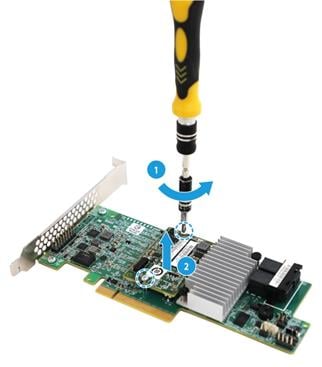
b. Remove the supercapacitor. Disconnect the supercapacitor extension cable, pull the clip on the supercapacitor holder, and take the supercapacitor out of the holder, as shown in Figure 88.
Figure 88 Removing the supercapacitor
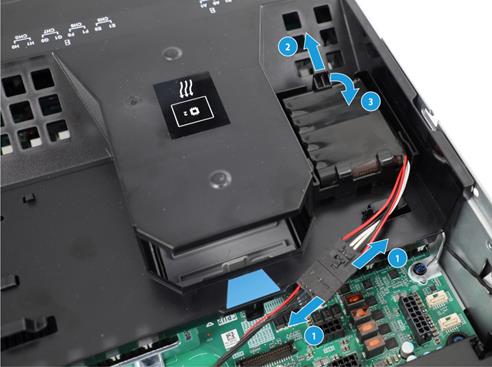
Installing a standard storage controller and a power fail safeguard module
1. (Optional.) Install a supercapacitor, as shown in Figure 89:
a. Install the supercapacitor. Tilt the supercapacitor and insert one end of the supercapacitor into the supercapacitor holder. Pull the clip on the holder and insert the other end into the holder, and then release the clip.
b. Connect one end of a supercapacitor extension cable to the supercapacitor.
Figure 89 Installing a supercapacitor

2. Install the removed flash card on the power fail safeguard module:
a. Install the internal threaded studs supplied with the power fail safeguard module on the standard storage controller.
b. Install the flash card on the standard storage controller. Align the two screw holes in the flash card with the threaded studs, insert the flash card, and use screws to secure the flash card, as shown in Figure 90.
Figure 90 Installing the flash card

3. Install the standard storage controller on the riser card. For more information, see ".Installing a riser card and a PCIe module."
4. Install the riser card on the server. For more information, see ".Installing a riser card and a PCIe module."
5. Connect the cables for the standard storage controller to the drive backplane. For more information, see "Connecting internal cables."
6. If a supercapacitor is installed, connect the supercapacitor extension cable to the flash card. For more information, see "Connecting supercapacitor extension cables."
7. Install the access panel. For more information, see "Installing the access panel."
8. Rack-mount the server. For more information, see "Rack-mounting the server."
9. Connect the power cord. For more information, see "Connecting the power cord."
10. Power on the server. For more information, see "Powering on the server."
Replacing a GPU module
Guidelines
When you install single-width HHHL GPUs, use Table 10 to select slots and follow these restrictions and guidelines:
· You can install a maximum of 6 GPUs.
· You must install the GPUs in x16 PCIe slots.
· Make sure each fan slot is installed with a FAN-H-4UG5 high-performance fan module.
Table 10 Recommended slots for HHHL GPUs
|
Number of GPUs |
Recommended slots |
|
1 |
slot 4 |
|
2 |
slot 4/5 |
|
3 |
slot 4/5/7 |
|
4 |
slot 4/5/7/8 |
|
5 |
slot 4/5/6//7/8 |
|
6 |
slot 1/4/5/6/7/8 |
|
|
NOTE: · For more information about slot locations, see Appendix A Specifications and Support Information. · For more information about riser card, PCIe slot, and processor mappings, see Appendix A Specifications and Support Information. |
Prerequisites
Take the following ESD prevention measures:
· Wear antistatic clothing.
· Wear an ESD wrist strap and make sure it makes good skin contact and is reliably grounded.
· Do not wear any conductive objects, such as jewelry or watches.
When you replace a component, examine the slot and connector for damages. Make sure the pins are not damaged (bent for example) and do not contain any foreign objects.
Removing a GPU module
1. Power off the server. For more information, see "Powering off the server."
2. Remove the server from the rack. For more information, see "Removing the server from a rack."
3. Remove the access panel. For more information, see "Removing the access panel."
4. Disconnect all cables that hinder the replacement, if any.
5. Remove the riser card where the GPU module resides. For more information, see "Removing a riser card and a PCIe module."
6. Remove the GPU module from the riser card. Open the retaining latch on the riser card, and pull the GPU module out of the slot, as shown in Figure 91.
Figure 91 Removing the GPU module from the riser card

Installing a GPU module
1. Install a GPU module on the riser card. Insert the GPU module into the PCIe slot along the guide rails, and then close the retaining latch.
Figure 92 Installing the GPU module on the riser card

2. Reconnect other cables to the riser card, if any.
3. Install the riser card on the server. For more information, see "Installing a riser card and a PCIe module."
4. Install the access panel. For more information, see "Installing the access panel."
5. Rack-mount the server. For more information, see "Rack-mounting the server."
6. Connect the power cord. For more information, see "Connecting the power cord."
7. Power on the server. For more information, see "Powering on the server."
Replacing a standard PCIe network adapter
|
WARNING! To avoid bodily injury from hot surfaces, allow the server and its internal modules to cool before touching them. |
Guidelines
To install a standard PCIe network adapter, a riser card is required. For more information about riser card and PCIe module compatibility, see Appendix A Specifications and Support Information.
Prerequisites
Take the following ESD prevention measures:
· Wear antistatic clothing.
· Wear an ESD wrist strap and make sure it makes good skin contact and is reliably grounded.
· Do not wear any conductive objects, such as jewelry or watches.
When you replace a component, examine the slot and connector for damages. Make sure the pins are not damaged (bent for example) and do not contain any foreign objects.
Removing a standard PCIe network adapter
1. Power off the server. For more information, see "Powering off the server."
2. Disconnect cables from the standard PCIe network adapter.
3. Remove the server from the rack. For more information, see "Removing the server from a rack."
4. Remove the access panel. For more information, see "Removing the access panel."
5. Disconnect all cables that hinder the replacement, if any.
6. Remove the riser card that holds the PCIe network adapter. For more information, see "Removing a riser card and a PCIe module."
7. Remove the PCIe network adapter. For more information, see "Removing a riser card and a PCIe module."
Installing a standard PCIe network adapter
For more information, see "Installing a riser card and a PCIe module."
Replacing an OCP network adapter
|
WARNING! To avoid bodily injury from hot surfaces, allow the server and its internal modules to cool before touching them. |
The OCP network adapter supports NCSI. By default, port 1 on the OCP network adapter acts as the HDM shared network port. You can configure another port on the OCP network adapter as the HDM shared network port from the HDM Web interface. For more information, see HDM online help.
Guidelines
You can install an OCP network adapter in slot 16. For information about the OCP adapter connectors on the system board, see Appendix A Specifications and Support Information.
Some operating systems support managed hot removal of specific OCP network adapters. For more information, see Appendix B Managed removal of OCP network adapters. This section describes the procedure to replace an OCP network adapter when the server is powered off.
Prerequisites
Take the following ESD prevention measures:
· Wear antistatic clothing.
· Wear an ESD wrist strap and make sure it makes good skin contact and is reliably grounded.
· Do not wear any conductive objects, such as jewelry or watches.
When you replace a component, examine the slot and connector for damages. Make sure the pins are not damaged (bent for example) and do not contain any foreign objects.
Removing an OCP network adapter
1. Power off the server. For more information, see "Powering off the server."
2. Disconnect all cables from the OCP network adapter.
3. Remove the OCP network adapter. Loosen the captive screws on the OCP network adapter and pull the OCP network adapter out from the chassis.
Figure 93 Removing the OCP network adapter

Installing an OCP network adapter
1. Install an OCP network adapter. Insert the OCP network adapter into the slot and fasten the captive screws on the network adapter, as shown in Figure 94.
Figure 94 Installing an OCP network adapter
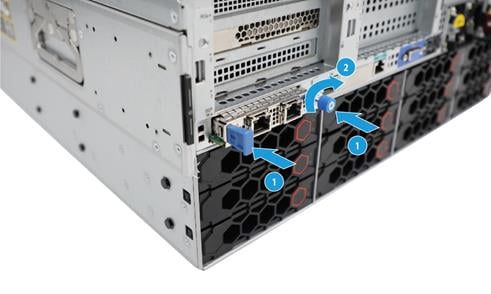
2. Connect external cables to the OCP network adapter.
3. Power on the server. For more information, see "Powering on the server."
4. (Optional.) Configure a network port on the OCP network adapter as the HDM shared network port.
Replacing a SATA M.2 SSD and a SATA M.2 SSD expander module
Guidelines
|
WARNING! To avoid bodily injury from hot surfaces, allow the server and its internal modules to cool before touching them. |
An M.2 expander module is required for SATA M.2 SSDs. You can install the expander module in a PCIe slot provided by a riser card. For more information, see "Connecting the SATA M.2 SSD data cables."
If you are installing two SATA M.2 SSDs, install two SATA M.2 SSDs of the same model to ensure high availability.
As a best practice, use SATA M.2 SSDs to install the operating system.
SSD slots are available on both sides of a SATA M.2 SSD expander module. If you replace a SATA M.2 SSD expander module, replace all SATA M.2 SSDs from the module and install them to the new module.
Prerequisites
Take the following ESD prevention measures:
· Wear antistatic clothing.
· Wear an ESD wrist strap and make sure it makes good skin contact and is reliably grounded.
· Do not wear any conductive objects, such as jewelry or watches.
· When you replace a component, examine the slot and connector for damages. Make sure the pins are not damaged (bent for example) and do not contain any foreign objects.
Removing a SATA M.2 SSD and a SATA M.2 SSD expander module
1. Power off the server. For more information, see "Powering off the server."
2. Remove the server from the rack. For more information, see "Removing the server from a rack."
3. Remove the access panel. For more information, see "Removing the access panel."
4. Remove all fan modules. For more information, see "Removing a fan module."
5. Remove the fan cage. For more information, see "Removing the fan cage."
6. Remove the SATA M.2 SSD expander module that holds the SATA M.2 SSD:
a. Disconnect the cable from the SATA M.2 SSD expander module.
b. Remove the expander module. Remove the screws at both ends of the module that secure the expander module and then pull the expander module out, as shown in Figure 95.
Figure 95 Removing the SATA M.2 SSD expander module
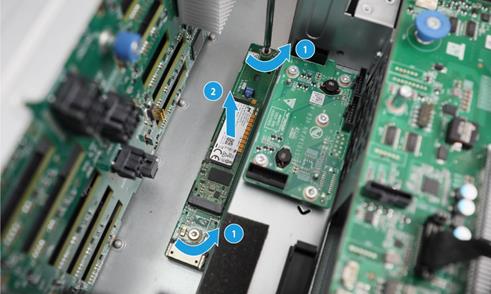
7. Remove a SATA M.2 SSD. Slide the locking tab, lift the SSD, and then pull the SSD out of the slot, as shown in Figure 96.
Figure 96 Removing a SATA M.2 SSD
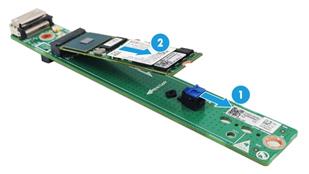
Installing a SATA M.2 SSD and a SATA M.2 SSD expander module
1. Install a SATA M.2 SSD to the SATA M.2 SSD expander module. Insert the connector of the SSD into the socket, slide the locking tab, press the SSD to secure the SSD into place, and then release the locking tab, as shown in Figure 97.
Figure 97 Installing a SATA M.2 SSD to the SATA M.2 SSD expander module
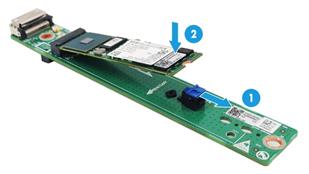
2. Install the expander module.
a. Align the two screw holes in the expander module with the two internal threaded studs on the chassis, put the expander module onto the chassis, and then use screws to secure the expander module, as shown in Figure 98.
b. Connect the SATA M.2 SSD cable. For more information, see "Connecting the SATA M.2 SSD data cables."
Figure 98 Installing the SATA M.2 SSD expander module
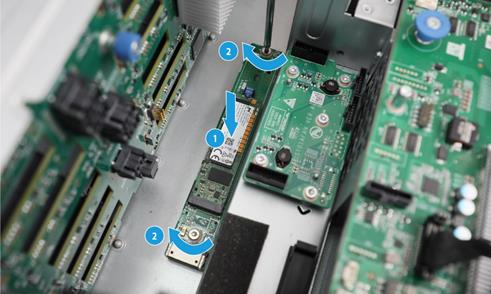
3. Install the fan cage. For more information, see "Installing the fan cage."
4. Install all the fan modules. For more information, see "Installing a fan module."
5. Install the access panel. For more information, see "Installing the access panel."
6. Rack-mount the server. For more information, see "Rack-mounting the server."
7. Connect the power cord. For more information, see "Connecting the power cord."
8. Power on the server. For more information, see "Powering on the server."
Replacing a dual SD card extended module
Prerequisites
Take the following ESD prevention measures:
· Wear antistatic clothing.
· Wear an ESD wrist strap and make sure it makes good skin contact and is reliably grounded.
· Do not wear any conductive objects, such as jewelry or watches.
When you replace a component, examine the slot and connector for damages. Make sure the pins are not damaged (bent for example) and do not contain any foreign objects.
Removing a dual SD card extended module
1. Power off the server. For more information, see "Powering off the server."
2. Remove the server from the rack. For more information, see "Removing the server from a rack."
3. Remove the access panel. For more information, see "Removing the access panel."
4. Remove the riser card cage that might hinder the replacement.
5. Remove the dual SD card extended module. Press the top clip and the side clip on the dual SD card extended module and pull the module out of the connector, as shown in Figure 99.
Figure 99 Removing the dual SD card extended module

6. Remove all SD cards from the extended module. Press an SD card to release it and then pull the SD card out of the slot, as shown in Figure 100.
Figure 100 Removing all SD cards from the extended module
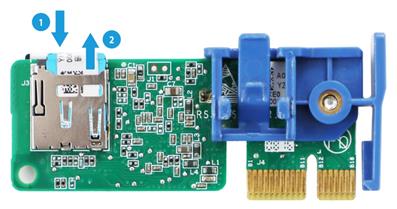
Installing a dual SD card extended module
1. Install SD cards on the dual SD card extended module. Insert an SD card into the slot and gently press the SD card to secure it in the slot, as shown in Figure 101.
Figure 101 Installing all the removed SD cards
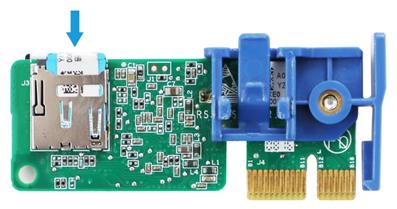
2. Install the dual SD card extended module on the server. Insert the extender module into the slot along the guide rails until you hear a click, as shown in Figure 102.
Figure 102 Installing the dual SD card extended module

3. Install the removed riser card, if any.
4. Install the access panel. For more information, see "Installing the access panel."
5. Rack-mount the server. For more information, see "Rack-mounting the server."
6. Connect the power cord. For more information, see "Connecting the power cord."
7. Power on the server. For more information, see "Powering on the server."
Replacing an SD card
Prerequisites
Take the following ESD prevention measures:
· Wear antistatic clothing.
· Wear an ESD wrist strap and make sure it makes good skin contact and is reliably grounded.
· Do not wear any conductive objects, such as jewelry or watches.
When you replace a component, examine the slot and connector for damages. Make sure the pins are not damaged (bent for example) and do not contain any foreign objects.
Removing an SD card
1. Power off the server. For more information, see "Powering off the server."
2. Remove the server from the rack. For more information, see "Removing the server from a rack."
3. Remove the access panel. For more information, see "Removing the access panel."
4. Remove the riser card cage that hinders the replacement.
5. Remove the dual SD card extended module. Press the top clip and the side clip on the dual SD card extended module and pull the module out of the connector, as shown in Figure 103.
Figure 103 Removing the dual SD card extended module
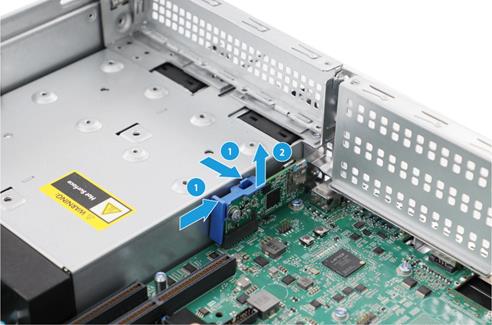
6. Remove each of the SD cards from the extended module. Gently press an SD card to release it and pull the SD card out of the slot.
Figure 104 Removing an SD card
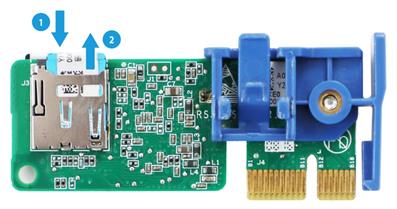
Installing an SD card
1. Install a new SD card. Insert the SD card into the slot and gently press the SD card to secure it in the slot, as shown in Figure 105.
Figure 105 Installing an SD card
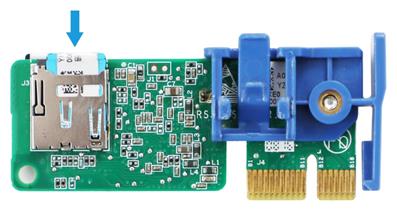
2. Install the dual SD card extended module on the server. Align the blue grooves in the extended module with the standout on the side panel of the power supply cage, and insert the extended module into the slot until you hear a click, as shown in Figure 106.
Figure 106 Installing the dual SD card extended module
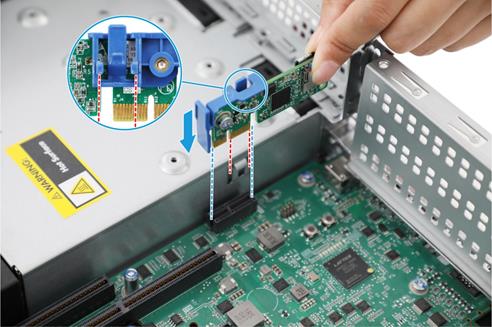
3. Install the removed riser card cage.
4. Install the access panel. For more information, see "Installing the access panel."
5. Rack-mount the server. For more information, see "Rack-mounting the server."
6. Connect the power cord. For more information, see "Connecting the power cord."
7. Power on the server. For more information, see "Powering on the server."
Replacing a chassis ear
Replace a chassis ear if it fails or any of the components (for example, I/O components or VGA/USB 3.0 connector) fails.
The procedure is the same for replacing the left and right chassis ears, except that you must also remove and install the chassis-open alarm module when replacing the left chassis ear. This section replaces the left chassis ear as an example.
Removing a chassis ear
1. Power off the server. For more information, see "Powering off the server."
2. Remove the server from the rack. For more information, see "Removing the server from a rack."
3. Remove the access panel. For more information, see "Removing the access panel."
4. Remove the chassis air baffle. For more information, see "Removing the chassis air baffle."
5. Remove all the fan modules. For more information, see "Removing a fan module."
6. Remove the fan cage. For more information, see "Removing the fan cage."
7. Disconnect the cable assembly for front I/O components and the chassis-open alarm module from the system board.
8. Remove the chassis-open alarm module. Remove the screws that secure the alarm module from the outside of the chassis, as shown in Figure 107.
Figure 107 Removing the screws that secure the chassis-open alarm module
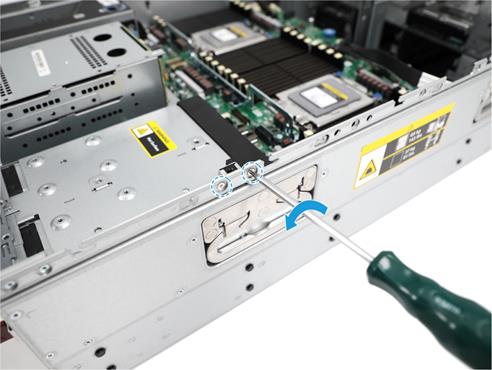
9. Remove the screws that secure the left chassis ear, as shown in Figure 108.
Figure 108 Removing the screws that secure the chassis ear
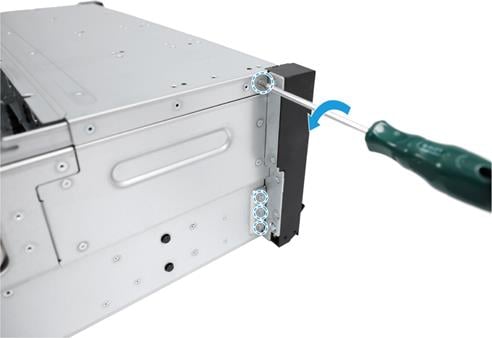
10. Remove the chassis ear, as shown in Figure 109.
a. Remove the four screws that secure the cable protection plate, as shown by callout 1.
b. Slide the plate towards the server front, and then remove the plate, as shown by callouts 2 and 3.
c. Take the chassis ear and the cable assembly out of the chassis, as shown by callout 4.
Figure 109 Removing the chassis ear
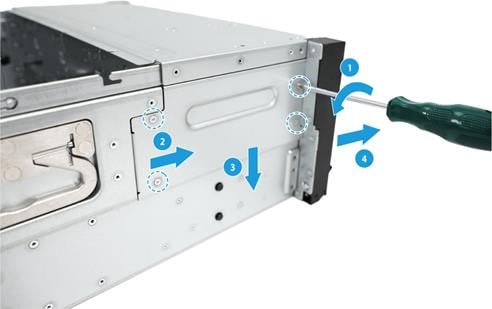
Installing a chassis ear
1. Install a chassis ear.
a. Attach the chassis ear to the server, as shown by callout 1 in Figure 110.
b. Close the cable protection plate, as shown by callouts 2 and 3 in Figure 110.
c. Fasten the two screws that secure the plate, as shown by callout 4 in Figure 110.
Figure 110 Installing the cable protection plate

d. Fasten screws that secure the chassis ear, as shown in Figure 111.
Figure 111 Installing the chassis ear
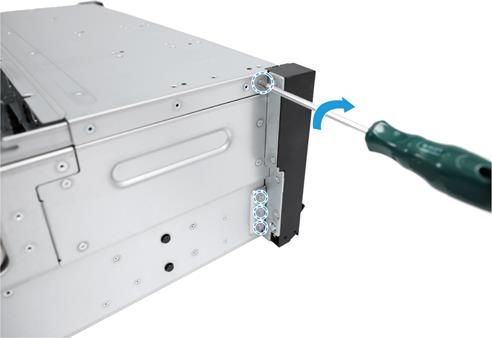
2. Install the chassis-open alarm module.
Figure 112 Installing the chassis-open alarm module

3. Connect the cable assembly for front I/O components and the chassis-open alarm module to the system board.
4. Install the fan cage. For more information, see "Installing the fan cage."
5. Install all fan modules. For more information, see "Installing a fan module."
6. Install the chassis air baffle. For more information, see "Installing the chassis air baffle."
7. Install the access panel. For more information, see "Installing the access panel."
8. Rack-mount the server. For more information, see "Rack-mounting the server."
9. Connect the power cord. For more information, see "Connecting the power cord."
10. Power on the server. For more information, see "Powering on the server."
Replacing a fan module
Guidelines
The fan modules are hot swappable.
The server must be fully configured with same model fans.
If sufficient space is available for replacement, you can replace a fan module without removing the server from the rack.
If you install a GPU, make sure the FAN-H-4UG5 high-performance fan modules are used.
Removing a fan module
1. Power off the server. For more information, see "Powering off the server."
2. Remove the server from the rack. For more information, see "Removing the server from a rack."
3. Remove the access panel. For more information, see "Removing the access panel."
4. Remove a fan module. Hold the fan module by the notches and pull the fan module out of the chassis, as shown in Figure 113.
Figure 113 Removing a fan module
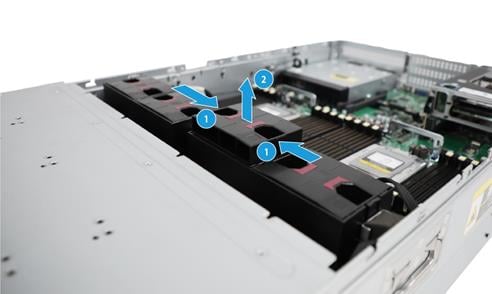
Installing a fan module
1. Install a fan module. Insert the fan module into the slot and press the module gently until it is secured in position, as shown in Figure 114.
Figure 114 Installing a fan module
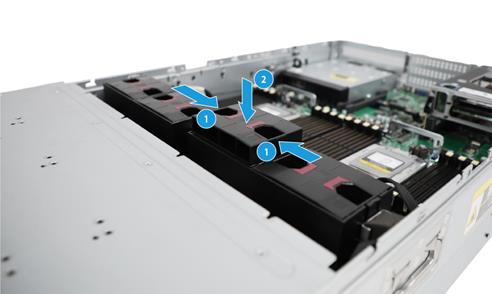
2. Install the access panel. For more information, see "Installing the access panel."
3. Rack-mount the server. For more information, see "Rack-mounting the server."
4. Connect the power cord. For more information, see "Connecting the power cord."
5. Power on the server. For more information, see "Powering on the server."
Installing and setting up a TCM or TPM
Trusted platform module (TPM) is a microchip embedded in the system board. It stores encryption information (such as encryption keys) for authenticating server hardware and software. The TPM operates with drive encryption programs such as Microsoft Windows BitLocker to provide operating system security and data protection. For information about Microsoft Windows BitLocker, visit the Microsoft website at http://www.microsoft.com.
Trusted cryptography module (TCM) is a trusted computing platform-based hardware module with protected storage space, which enables the platform to implement password calculation.
Installation and setup flowchart
Figure 115 TCM/TPM installation and setup flowchart
Guidelines
· Do not remove an installed TCM or TPM. Once installed, the module becomes a permanent part of the system board.
· If you want to replace the failed TCM or TPM, remove the system board, and then contact H3C Support to replace the TCM or TPM and the system board.
· When installing or replacing hardware, H3C technicians cannot configure the TCM or TPM or enter the recovery key. For security reasons, only the user can perform the tasks.
· When replacing the system board, do not remove the TCM or TPM from the system board. H3C will provide a TCM or TPM with a spare system board for the replacement.
· Any attempt to remove an installed TCM or TPM from the system board breaks or disfigures the TCM or TPM security rivet. Upon locating a broken or disfigured rivet on an installed TCP or TPM, administrators should consider the system compromised and take appropriate measures to ensure the integrity of the system data.
· H3C is not liable for blocked data access caused by improper use of the TCM or TPM. For more information, see the encryption technology feature documentation provided by the operating system.
Prerequisites
Take the following ESD prevention measures:
· Wear antistatic clothing.
· Wear an ESD wrist strap and make sure it makes good skin contact and is reliably grounded.
· Do not wear any conductive objects, such as jewelry or watches.
When you replace a component, examine the slot and connector for damages. Make sure the pins are not damaged (bent for example) and do not contain any foreign objects.
Installing a TCM or TPM
1. Power off the server. For more information, see "Powering off the server."
2. Remove the server from the rack. For more information, see "Removing the server from a rack."
3. Remove the access panel. For more information, see "Installing the access panel."
4. Remove all riser cards that hider the installation, if any.
5. Install the TCM or TPM.
The installation procedure is the same for a TPM and a TCM. The following information uses a TPM to show the procedure:
a. Press the TPM into the TPM connector on the system board, as shown by callout 1 in Figure 116.
b. Insert the rivet pin, as shown by callout 2 in Figure 116.
c. Insert the security rivet into the hole in the rivet pin and press the security rivet until it is firmly seated, as shown by callout 3 in Figure 116.
Figure 116 Installing the TPM module
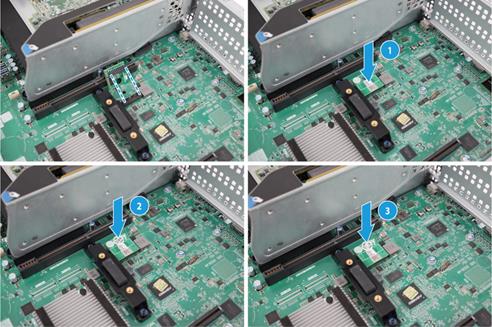
6. Install the removed riser cards, if any.
7. Install the access panel. For more information, see "Installing the access panel."
8. Rack-mount the server. For more information, see "Rack-mounting the server."
9. Connect the power cord. For more information, see "Connecting the power cord."
10. Power on the server. For more information, see "Powering on the server."
Enabling the TCM or TPM in the BIOS
1. Access the BIOS utility. For information about how to enter the BIOS utility, see the BIOS user guide.
2. Select Advanced > Trusted Computing, and press Enter.
3. Enable TCM or TPM. By default, the TCM and TPM are enabled for a server.
If the server is installed with a TPM, select TPM State > Enabled, and then press Enter.
If the TPM is installed with a TCM, select TCM State > Enabled, and then press Enter.
4. Log in to HDM to verify that the TCM or TPM is operating correctly. For more information, see HDM online help.
Configuring encryption in the operating system
For more information about this task, see the encryption technology feature documentation that came with the operating system.
The recovery key/password is generated during BitLocker setup, and can be saved and printed after BitLocker is enabled. When using BitLocker, always retain the recovery key/password. The recovery key/password is required to enter Recovery Mode after BitLocker detects a possible compromise of system integrity or firmware or hardware change.
For security purposes, follow these guidelines when retaining the recovery key/password:
· Always store the recovery key/password in multiple locations.
· Always store copies of the recovery key/password away from the server.
· Do not save the recovery key/password on the encrypted hard drive.
For more information about Microsoft Windows BitLocker drive encryption, visit the Microsoft website at http://technet.microsoft.com/en-us/library/cc732774.aspx.
Replacing a power supply
Guidelines
· To avoid damage to hardware, use only H3C approved power supplies.
· The server supports 1+1 power supply redundancy.
· The power supplies installed on the server must be the same model. If they differ in model, HDM would raise an alarm.
· The power supplies are hot swappable.
· The system provides an overtemperature mechanism for power supplies. The power supplies automatically turn off when they encounter an overtemperature situation and automatically turn on when the overtemperature situation is removed.
For more information about the specifications of power supplies, see the power supply manuals for them.
Prerequisites
Take the following ESD prevention measures:
· Wear antistatic clothing.
· Wear an ESD wrist strap and make sure it makes good skin contact and is reliably grounded.
· Do not wear any conductive objects, such as jewelry or watches.
When you replace a component, examine the slot and connector for damages. Make sure the pins are not damaged (bent for example) and do not contain any foreign objects.
Removing a power supply
If two operating power supplies are present and the server rear has sufficient space for replacement, you can replace one of the power supplies without powering off the server.
To remove a power supply:
1. Power off the server. For more information, see "Powering off the server."
2. Remove the server from the rack. For more information, see "Removing the server from a rack."
3. Remove the power cord from the power supply.
You can secure a power cord by using a Velcro cable strap or a cable clamp. This section describes how to remove a power cord secured by a cable clamp.
a. Press the tab to disengage the ratchet from the tie mount, slide the cable clamp outward, and then release the tab, as shown by callouts 1 and 2 in Figure 117.
b. Open the cable clamp and remove the power cord out of the clamp, as shown by callouts 3 and 4 in Figure 117.
c. Unplug the power cord, as shown by callout 5 in Figure 117.
Figure 117 Removing the power cord
4. Remove the power supply. Holding the power supply by its handle and pressing the retaining latch with your thumb, pull the power supply slowly out of the slot, as shown in Figure 118.
Figure 118 Removing the power supply
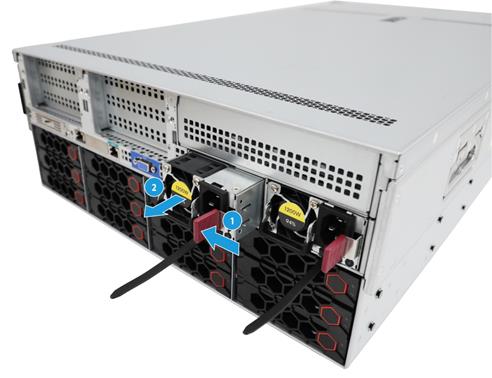
Installing a power supply
If only one power supply is present, install the new power supply in the slot for the replaced power supply.
To install a power supply:
1. Install a new power supply. Orient the power supply so that the lettering on the label is upright, and then push the power supply into the slot until you hear a click, as shown in Figure 119.
Figure 119 Installing the power supply
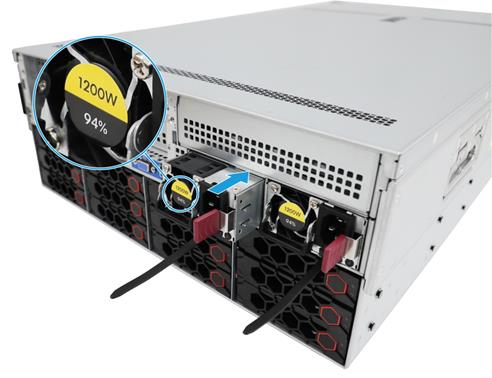
2. Rack-mount the server. For more information, see "Rack-mounting the server."
3. Connect the power cord. For more information, see "Connecting the power cord."
4. Power on the server. For more information, see "Powering on the server."
Replacing the NVMe VROC module
|
WARNING! To avoid bodily injury from hot surfaces, allow the server and its internal modules to cool before touching them. |
Removing the NVMe VROC module
1. Power off the server. For more information, see "Powering off the server."
2. Remove the server from the rack. For more information, see "Removing the server from a rack."
3. Remove the access panel. For more information, see "Removing the access panel."
4. Remove the NVMe VROC module. Hold the ring part of the NVMe VROC module and pull the module out, as shown in Figure 120.
Figure 120 Removing the NVMe VROC module
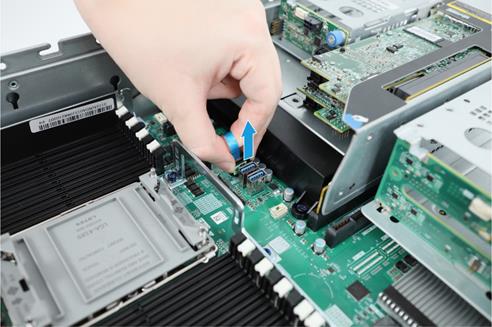
Installing the NVMe VROC module
1. Install a new NVMe VROC module. Insert the NVMe VROC module onto the NVMe VROC module connector on the system board, as shown in Figure 121.
Figure 121 Installing an NVMe VROC module

2. Install the access panel. For more information, see "Installing the access panel."
3. Rack-mount the server. For more information, see "Rack-mounting the server."
4. Connect the power cord. For more information, see "Connecting the power cord."
5. Power on the server. For more information, see "Powering on the server."
Replacing the system battery
|
WARNING! To avoid bodily injury from hot surfaces, allow the server and its internal modules to cool before touching them. |
The server comes with a system battery (Panasonic BR2032) installed on the system board, which supplies power to the real-time clock and has a lifespan of 3 to 5 years. If the server no longer automatically displays the correct date and time, you might need to replace the battery. As a best practice, use the Panasonic BR2032 battery to replace the old one.
|
|
NOTE: The BIOS will restore to the default settings after the replacement. You must reconfigure the BIOS to have the desired settings, including the system date and time. For more information, see the BIOS user guide for the server. |
Prerequisites
Take the following ESD prevention measures:
· Wear antistatic clothing.
· Wear an ESD wrist strap and make sure it makes good skin contact and is reliably grounded.
· Do not wear any conductive objects, such as jewelry or watches.
When you replace a component, examine the slot and connector for damages. Make sure the pins are not damaged (bent for example) and do not contain any foreign objects.
Removing the system battery
1. Power off the server. For more information, see "Powering off the server."
2. Remove the server from the rack. For more information, see "Removing the server from a rack."
3. Remove the access panel. For more information, see "Removing the access panel."
4. Remove the system battery. Pinch the system battery by its top edge and the battery will disengage from the battery holder.
|
|
NOTE: For environment protection purposes, dispose of the used-up system battery at a designated site. |
Figure 122 Removing the system battery

Installing the system battery
1. Install the system battery.
a. Insert the system battery with the plus sign "+" facing up into the system battery holder, as shown by callout 1 in Figure 123.
b. Press down the battery to secure it into place, as shown by callout 2 in Figure 123.
Figure 123 installing the system battery
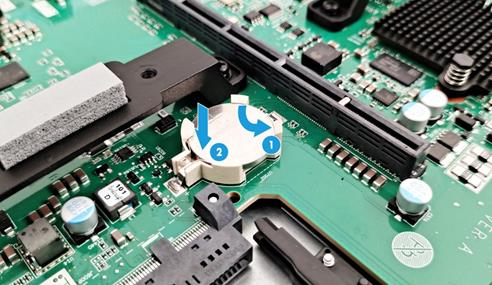
2. Install the access panel. For more information, see "Installing the access panel."
3. Rack-mount the server. For more information, see "Rack-mounting the server."
4. Connect the power cord. For more information, see "Connecting the power cord."
5. Power on the server. For more information, see "Powering on the server."
6. Access the BIOS to reconfigure the system date and time. For more information, see the BIOS user guide for the server.
Connecting internal cables
Guidelines
Follow these guidelines when connecting the internal cables:
· Do not route the cables above the removable components, such as DIMMs.
· Route the internal cables without hindering installation or removal of other components or hindering other internal components.
· Route the cables neat and tidy in their own fixed spaces. Make sure the cables will not be squeezed or scratched by other internal components.
· Do not pull the connectors when routing the cables.
· Do not use a cable tie to bundle an excessive number of cables.
· Appropriately bind long cables. Coil and use cable ties to secure unused cables.
· Connect the drive cables until they click into place.
· Remove the cap (if any) from the target cable connector before connecting a cable to it.
· If you cannot identify the cables by labels provided with the cables, apply new labels to cables for easy identification.
Connecting drive cables
Drive cables include SAS/SATA data cables, NVMe data cables, power cords, and signal cables. The server supports various drive configurations, each with a different cable scheme. This section describes drive cabling for the following two drive configurations:
· Front 24LFF drives+rear 12LFF drives+rear 4SFF UniBay drives+rear 2LFF drives
· Front 24LFF drives+rear 12LFF drives+rear 2SFF drives+rear 4LFF drives
For information about drive cabling for the other drive configurations, contact Technical Support.
Front 24LFF drives+rear 12LFF drives+rear 4SFF UniBay drives+rear 2LFF drives
This section uses one LSI 8i storage controller as an example.
To connect drive cables for the front 24LFF drives+rear 12LFF drives+rear 4SFF UniBay drives+rear 2LFF drives configuration:
1. Connect the SAS/SATA cable for the front 24LFF drive backplane.
Figure 124 Connecting the SAS/SATA cable for the front 24LFF drive backplane
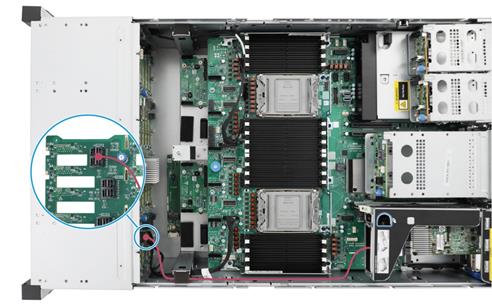
2. Connect NVMe data cables for the front 24LFF backplane. Connect the SlimSAS connectors on the backplane to the SlimSAS connectors on the system board.
Figure 125 Connecting NVMe data cables for the front 24LFF backplane
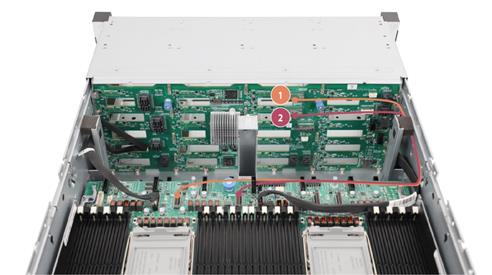
3. Connect AUX signal cables for the front 24LFF drive backplane.
Figure 126 Connecting AUX signal cables for the front 24LFF drive backplane
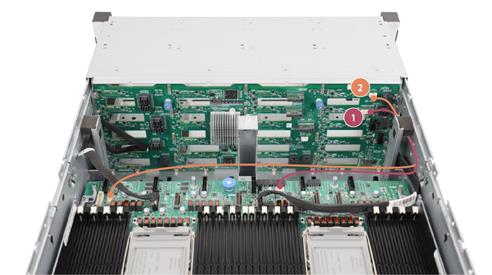
4. Connect power cords for the front 24LFF backplane.
Figure 127 Connecting power cords for the front 24LFF backplane

5. Connect SAS/SATA data cables, the power cord and the AUX signal cable for the rear 12LFF backplane.
You can route the power cord under or above the system board. For cabling under or above the system board, see Figure 128 or Figure 129, respectively.

|
(1) AUX data cable |
(2) SAS/SATA data cable 1 |
|
(3) SAS/SATA data cable 2 |
(4) Power cord |
Figure 129 Connecting the power cord for the rear 12LFF drive backplane (power cord above system board)

6. Connect power cords and AUX data cables for the rear 4SFF Unibay drive backplane and the rear 2LFF drive backplane.
Figure 130 Connecting power cords and AUX data cables for the rear 4SFF Unibay drive backplane and the rear 2LFF drive backplane
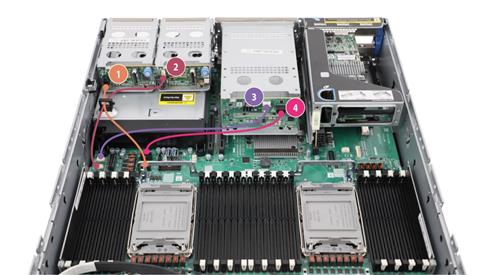
|
(1) Power cord for 4SFF UniBay |
(2) AUX data cable for 4SFF UniBay |
|
(3) AUX data cable for 2LFF |
(4) Power cord for 2LFF |
7. Connect SAS/SATA data cables for the rear 4SFF Unibay drive backplane and the rear 2LFF drive backplane.
Figure 131 Connecting SAS/SATA data cables for the rear 4SFF Unibay drive backplane and the rear 2LFF drive backplane
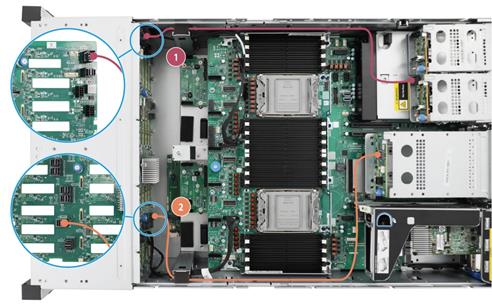
|
(1) SAS/SATA data cable for 4SFF UniBay |
(2) SAS/SATA data cable for 2LFF |
8. Connect NVMe cables for the rear 4SFF Unibay drive backplane.
Figure 132 Connecting NVMe cables for the rear 4SFF Unibay drive backplane
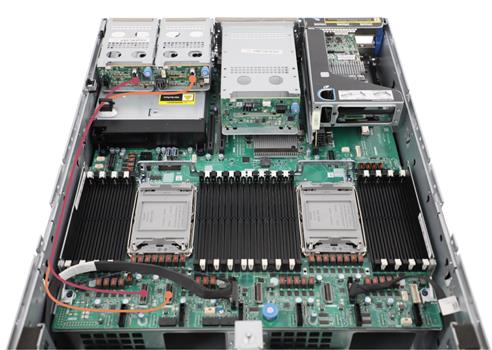
Front 24LFF drives+rear 12LFF drives+rear 2SFF drives+rear 4LFF drives
This section uses two 8i storage controllers in slots7 and 8 as an example to introduce the cabling method. For more information about the slot locations, see Appendix A Specifications and Support Information.
To connect drive cables for the front 24LFF drives+rear 12LFF drives+rear 2SFF drives+rear 4LFF drives configuration:
1. Connect SAS/SATA data cables for the front 24LFF drive backplane.
Figure 133 Connecting SAS/SATA data cables for the front 24LFF drive backplane (dual storage controllers)
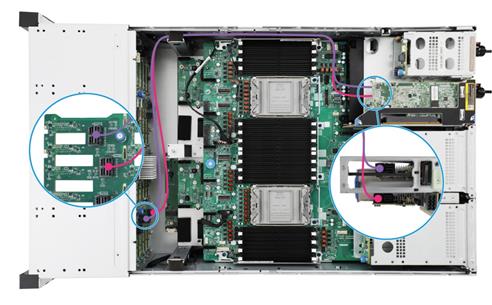
2. Connect NVMe data cables for the front 24LFF drive backplane, as shown in Figure 125.
3. Connect AUX signal cables for the front 24LFF drive backplane, as shown in Figure 126.
4. Connect power cords for the front 24LFF drive backplane, as shown in Figure 127.
5. Connect SAS/SATA data cables, the power cord, and the AUX signal cable for the rear 12LFF drive backplane, as shown in Figure 128 and Figure 129.
6. Connect power cords and AUX signal cables for the rear 2SFF and 4LFF drives backplanes.
Figure 134 Connecting power cords and AUX signal cables for the rear 2SFF and 4LFF drives backplanes
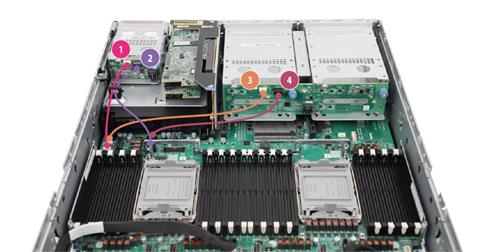
|
(1) AUX signal cable for 2SFF |
(2) Power cord for 2SFF |
|
(3) AUX signal cable for 4LFF |
(4) Power cord for 4LFF |
7. Connect SAS/SATA data cables for the rear 2SFF and 4LFF drive backplanes.
Figure 135 Connecting SAS/SATA data cables for the rear 2SFF and 4LFF drive backplanes
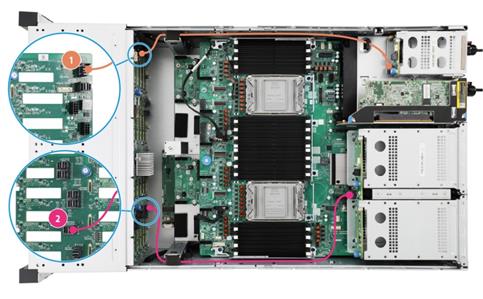
|
(1) SAS/SATA data cable for 2SFF |
(2) SAS/SATA data cable for 4LFF |
Connecting power cords for fan adapters
The server supports two fan adapters. Connect power cords to the power adapters as shown in Figure 136.
Figure 136 Connecting power cords for fan adapters

|
(1) Power cord 1 |
(2) Power cord 2 |
|
(3) Power cord 3 |
(4) Power cord 4 |
Connecting supercapacitor extension cables
Figure 137 Connecting supercapacitor extension cables
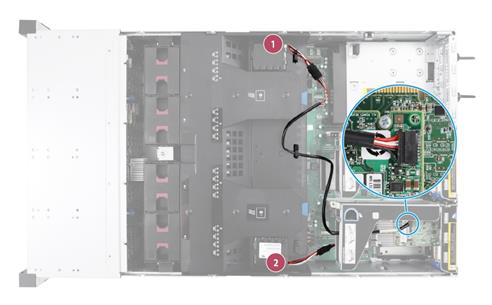
|
(1) Supercapacitor extension cable 1 |
(2) Supercapacitor extension cable 2 |
Connecting the SATA M.2 SSD data cables
Figure 138 Connecting the SATA M.2 SSD data cables
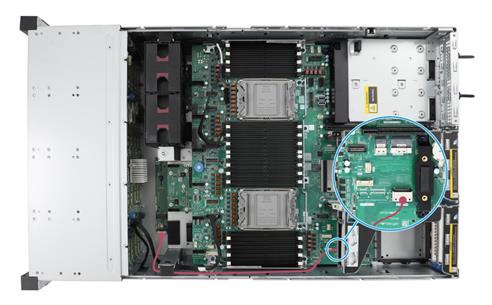
Connecting the PCIe signal cables
The RC-3FHFL-2U-SW-G5 riser card requires PCIe signal cables, whose cabling method varies by riser card installation location. Use Figure 139 and Table 11 to identify the cabling method.
Figure 139 Connecting the PCIe signal cables
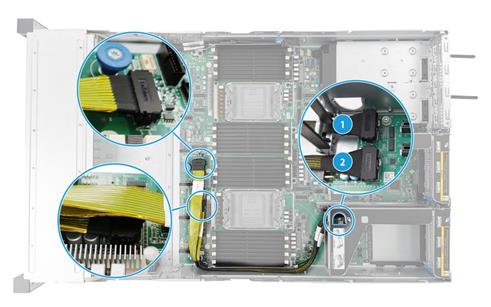
|
PCIe riser connector |
Cable code |
Cable number |
Connector on the riser card |
Connector on the system board |
|
Riser1 |
0404A1EB |
1 |
SlimSAS connector 1 |
LP SlimSAS connector A1/A2 |
|
2 |
SlimSAS connector 2 |
LP SlimSAS connector A3/A4 |
||
|
Riser2 |
0404A1ED |
1 |
SlimSAS connector 1 |
LP SlimSAS connector B1/B2 |
|
2 |
SlimSAS connector 2 |
LP SlimSAS connector B3/B4 |
||
|
If the slave processor is absent, its corresponding connector on the system board and PCIe slot on the riser card are unavailable. For more information about connectors and slots for slave processors, visit the query tool at http://www.h3c.com/cn/Service/Document_Software/Document_Center/Server/. |
||||
|
|
NOTE: If a processor is absent, the corresponding connectors on the system board and PCIe slots provided by riser cards are unavailable. For information about the corresponding connectors and PCIe slots for a processor, see riser card specifications in Appendix A Specifications and Support Information. |
Connecting cables to chassis ears
Figure 140 Connecting cables to chassis ears
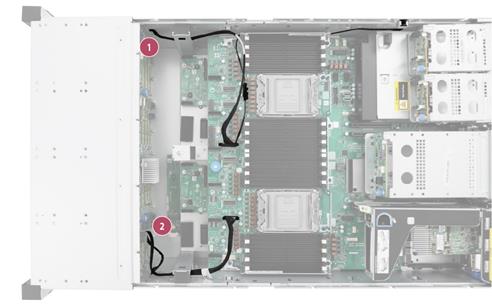
|
(1) Left chassis ear cable |
(2) Right chassis ear cable |
Maintenance
The following information describes the guidelines and tasks for daily server maintenance.
Guidelines
· Keep the equipment room clean and tidy. Remove unnecessary devices and objects from the equipment room.
· Make sure the temperature and humidity in the equipment room meet the server operating requirements.
· Regularly check the server from HDM for operating health issues.
· Keep the operating system and software up to date as required.
· Make a reliable backup plan:
¡ Back up data regularly.
¡ If data operations on the server are frequent, back up data as needed in shorter intervals than the regular backup interval.
¡ Check the backup data regularly for data corruption.
· Stock spare components on site in case replacements are needed. After a spare component is used, prepare a new one.
· Keep the network topology up to date to facilitate network troubleshooting.
Maintenance tools
The following are major tools for server maintenance:
· Temperature and humidity meter—Monitors the operating environment of the server.
· HDM and FIST—Monitors the operating status of the server.
Maintenance tasks
Observing LED status
Observe the LED status on the front and rear panels of the server to verify that the server modules are operating correctly. For more information about the status of the front and rear panel LEDs, see Appendix A Specifications and Support Information.
Monitoring the temperature and humidity in the equipment room
Use a hygrothermograph to monitor the temperature and humidity in the equipment room.
The temperature and humidity in the equipment room must meet the server requirements described in "Environment requirements."
Examining cable connections
Verify that the cables and power cords are correctly connected.
Guidelines
· Do not use excessive force when connecting or disconnecting cables.
· Do not twist or stretch the cables.
· Organize the cables appropriately. For more information, see "Cabling guidelines."
Checklist
· The cable type is correct.
· The cables are correctly and firmly connected and the cable length is appropriate.
· The cables are in good condition and are not twisted or corroded at the connection point.
Viewing server status
To view basic information and status of the subsystems of the server, see "View device information" in H3C Servers HDM User Guide.
Collecting server logs
For the procedure for collecting server logs, see "Download log" in H3C Servers HDM User Guide.
Updating firmware for the server
For the procedure for updating the HDM firmware, BIOS, or CPLD, see H3C Servers Firmware Update Guide.


